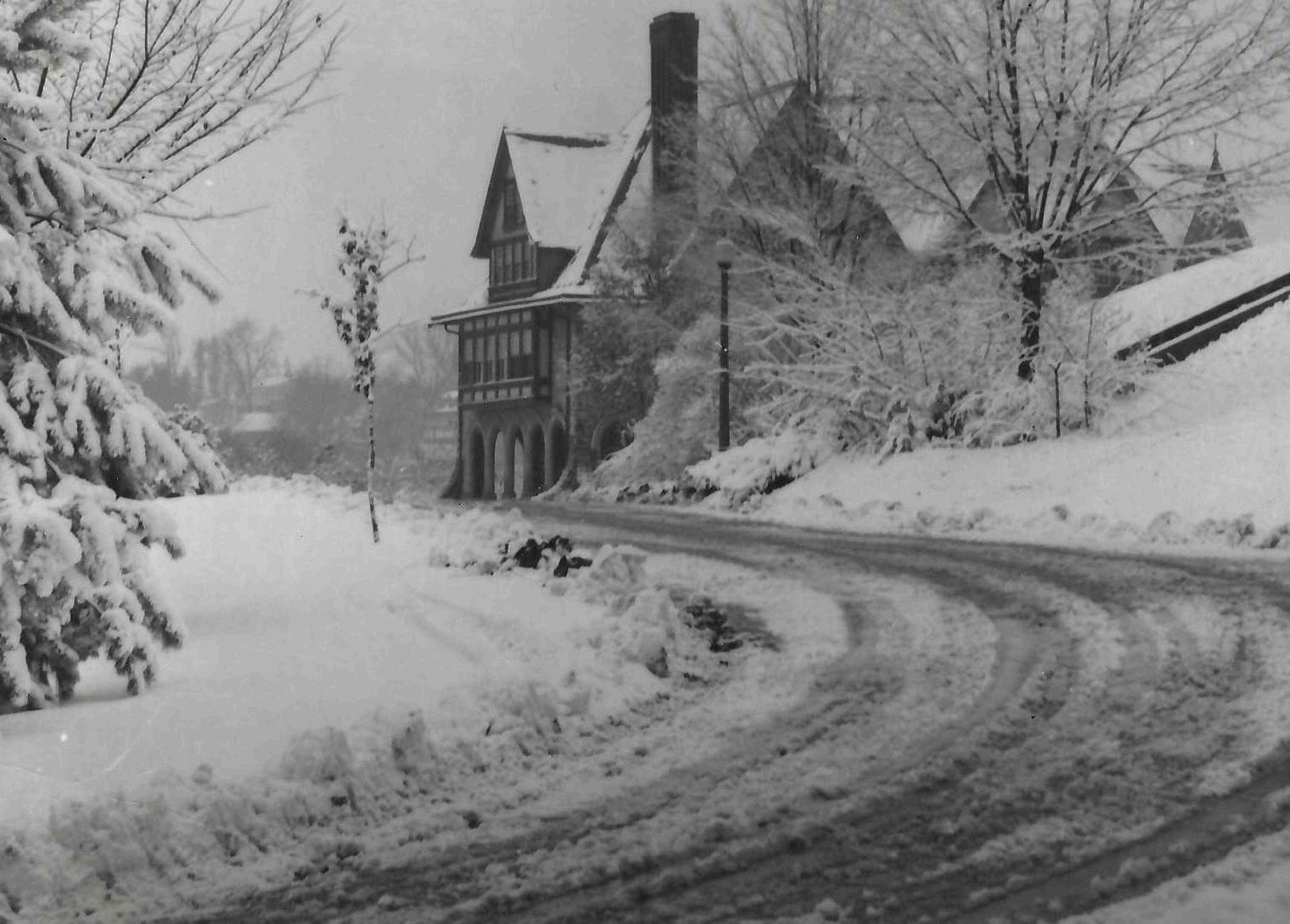




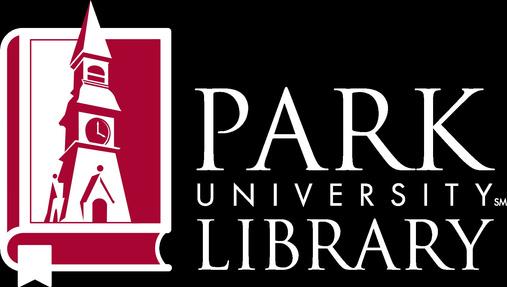
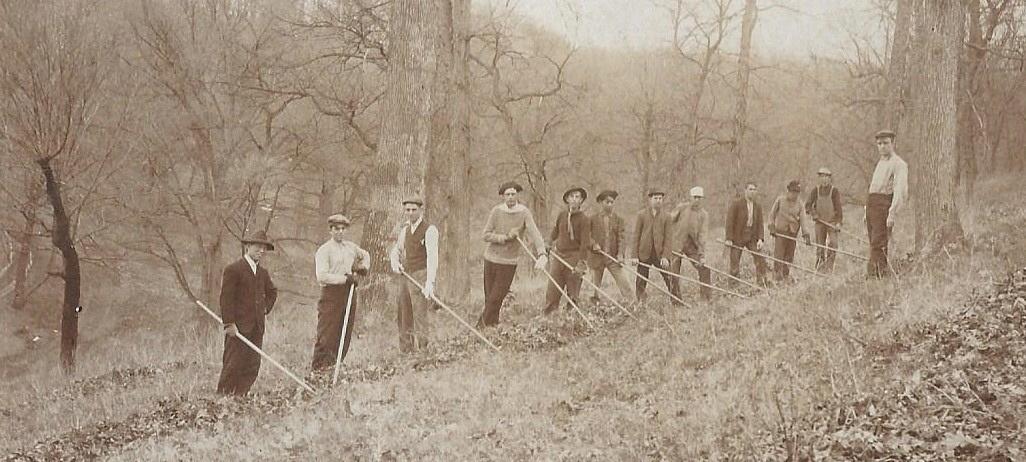
Library Director Message
Message from the Associate Archivist Recent Acquisitions
Furthering the Story
Angeline Washington Elementary School
Digital Imaging Grant Letter from Campus
National Teacher Appreciation Month
National Missionary Month
National Archives Month
First person account of the
Hoshio Iwakiri's '42 horrifying experience on Dec 7, 1941
National Bible Month
Fun Facts
A Century of Being Pirate Remembering Those That Served In Memoriaum “Pirate Chats”
In seasons of transition and change, I often find myself looking to the past for a path forward. This is especially true as I begin my first academic year as Park University’s director of library services In conversation and collaboration with Timothy Westcott, Ph D , Park University associate archivist and professor of history, I am struck by just how much of Park’s history is reflected back to us today
In this issue of The Archives magazine, you’ll see the rich fabric of Park’s past that tells a story of perseverance, strength and faith. Notably, this issue features the Park College Typhoid Epidemic of 1909-10 which threatened to devastate the institution via polluted water in the Missouri River. Detailed by firsthand accounts and reporting from The Stylus and local newspapers, this gripping account ends in resilience for Park.
You’ll also read the story of Hoshie Iwakiri, a 1942 Park graduate who bravely returned to school after being incarcerated by police on her way back to campus An account from her college roommate details the incident and the lasting impacts
Park’s rich history points us forward, too The testimony and analysis of Spencer Cave’s courageous and gentle care of student success can challenge us to think deeper about how we, too, can support today’s students.
I’m also excited to share that since the last issue of The Archives, Park University’s Frances Fishburn Archives and Special Collections received a 2024 Digital Imaging Grant, funded by the Missouri State Library In his relentless work to curate and celebrate Park’s history, Dr Westcott will support these grant efforts to digitize the George Shepard Park collection

Thank you for connecting with The Archives and for your support of the important collection, preservation and story-telling efforts conducted in the Fishburn Archives and Special Collections I hope that you will be as inspired by the past and challenged to move forward as I was in the pages ahead
Ever forward,
Camille A. Cook Director of Library Services
Assistant
Professor
of Library Services
Park University camille.cook@park.edu
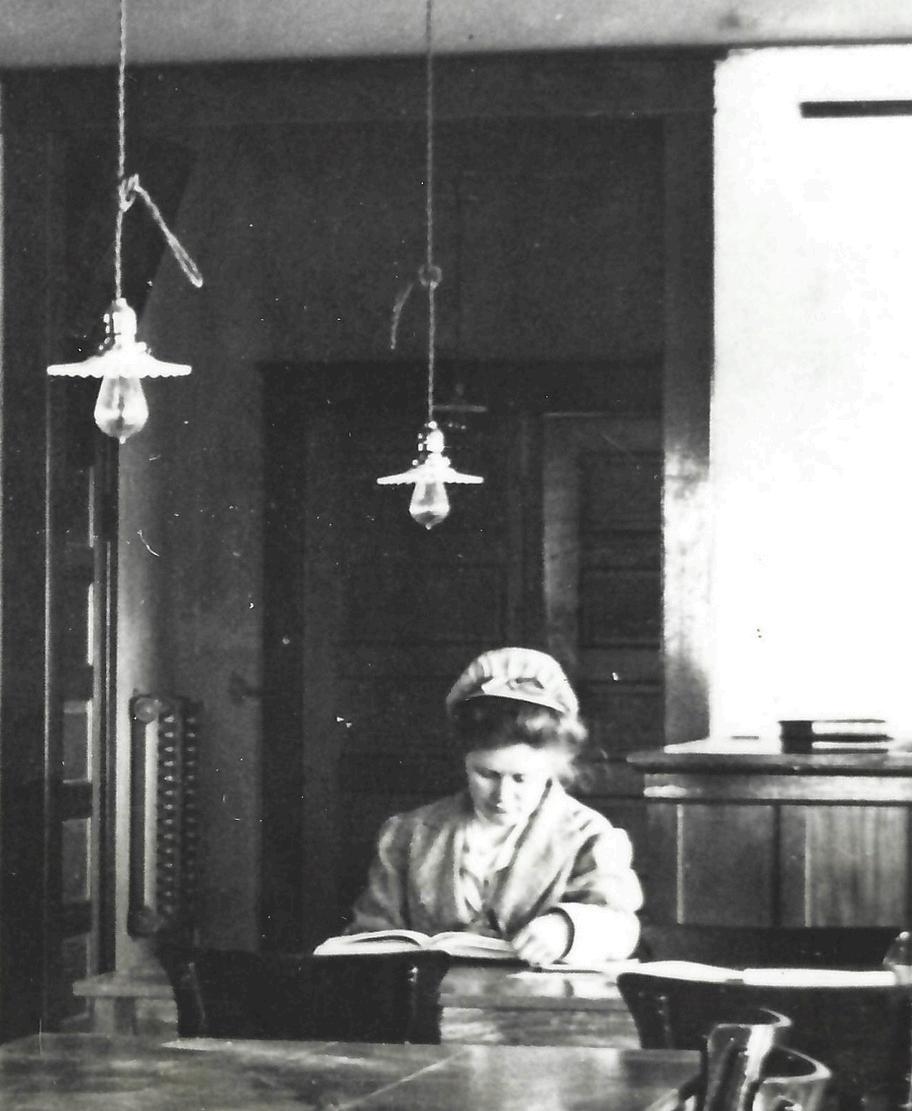
Recently, I traveled to Grafton, Vt , the hometown of the Park/Parke families, to conduct research into the namesake of Park University and the City of Parkville, Mo Grafton’s 2020 population was 645, down from 1,365 residents in 1810, the year before George Shepard Park was born.
The entire community extended the most hospitable welcome and notice in my visit. I thank Kimberly Record, Grafton town clerk; Maureen Fisher-Fletcher, administrator of the Grafton Historical Society; Mario Kenyon-Hernandez, president of the Grafton Historical Society; Richard Desrochers, current owner of the Park farm and son-in-law to Arthur Park, the last direct Park descendant residing in Grafton; Al and Noreen Sands, who own the farm that George was born and raised; and members of the Grafton Historical Society.
My deepest heartfelt gratitude goes to Craig Ruggless who hosted me over the two-day visit Craig and I started sharing e-mails in the fall of 2022 regarding a visit and over the past two years, that continued communication led to my visit and his knowledgeable tours of Grafton history and locales
Grafton is a stunning historical postcard Numerous homes and structures remain, which George Park would have known and visited The residence (circa 1793) of Craig belonged to Park’s great-great-grandfather, Thomas Kinne, one of Graton’s early settlers and a major landowner in the late 1780s
I researched original town land records related to Park’s descendants, Thomas Kinney Park (great-grandfather), Hezekiah Park (father) and Robert Park (uncle), and Park’s great-grandfather Hezekiah’s three former slaves Prince Park, Japhath Park and Nero Park who were freed at the beginning of the American Revolution, owning land, paying a poll tax and voting in 1813; original ledgers from the Barrett-Wheeler, Barrett, Wheeler and Palmer general stores where the Park families, including the freed men, made daily purchases, such as a lot of “drink and tobacco”; the Middletown and Burgess cemeteries where the Park family members are buried; the farmstead where George was born and raised until his departure to Illinois in 1830; stone foundations of the Barrett-Wheeler General Store and other locations; the original house and outbuildings of the Park farm; and the Grafton Historical Society
Visits like those to Grafton renew the significance, as Park University approaches its sesquicentennial, of the full Park family narrative Where next? The Park/Parke families were original settlers of Preston, Conn , (Preston received its name from the Parke estate in England, named Preston) before migrating to Grafton The family connections to Connecticut further the narrative of colonial America, their contexts to enslavement and the lasting connections, as a family tree, to Vermont, Missouri and Illinois
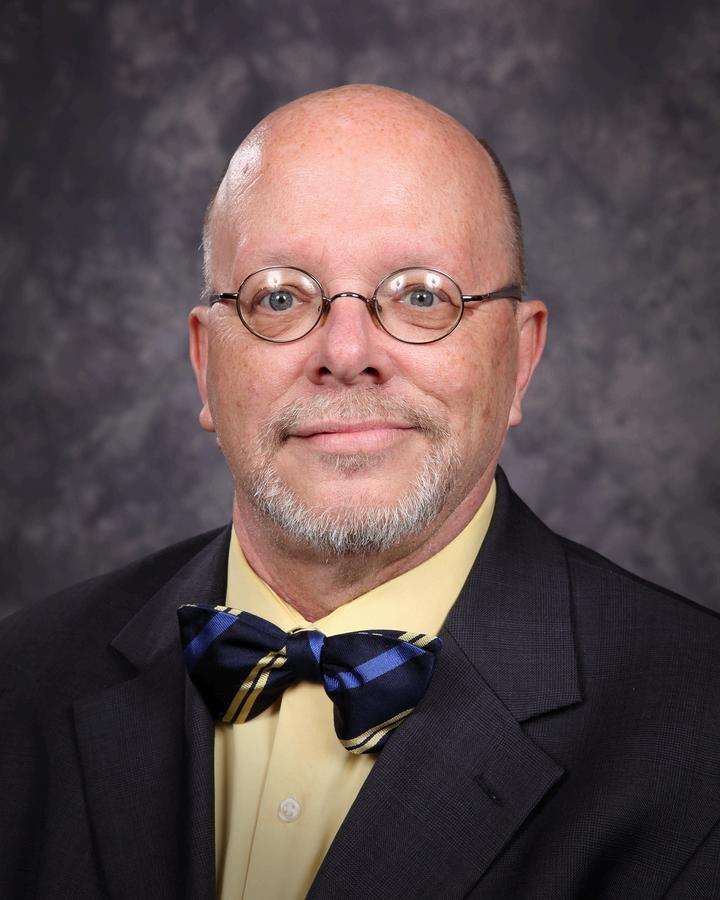
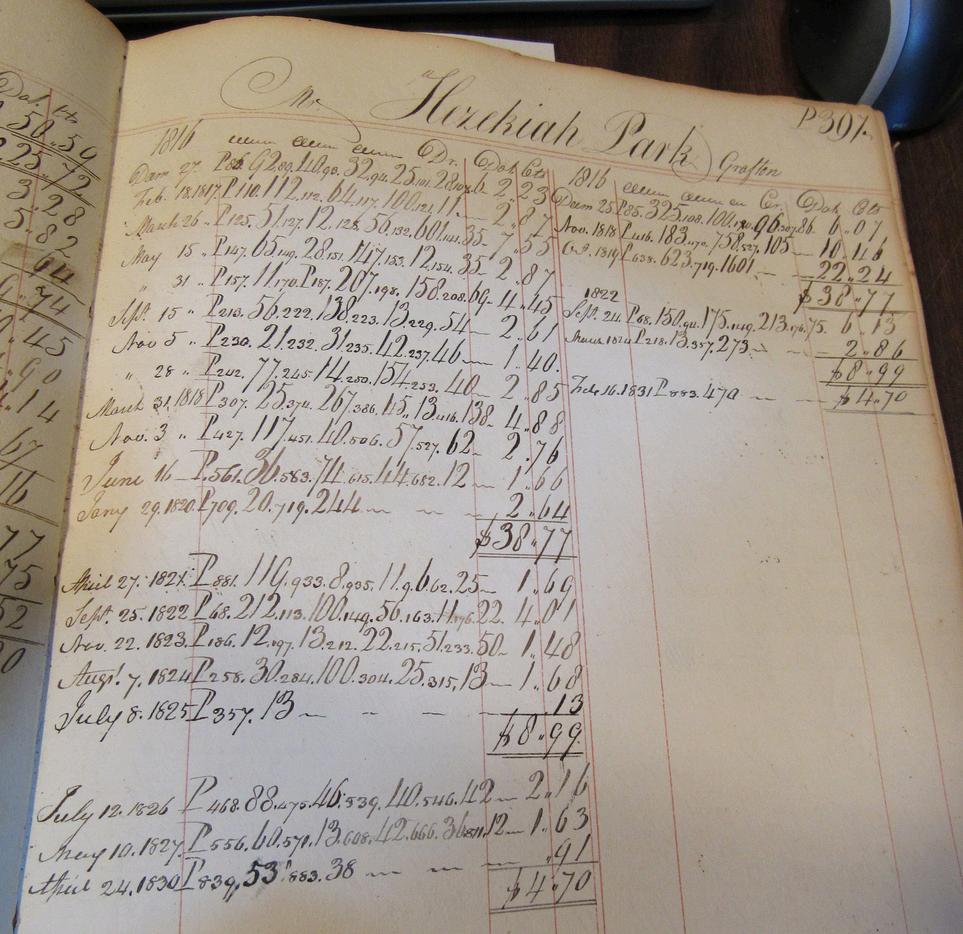


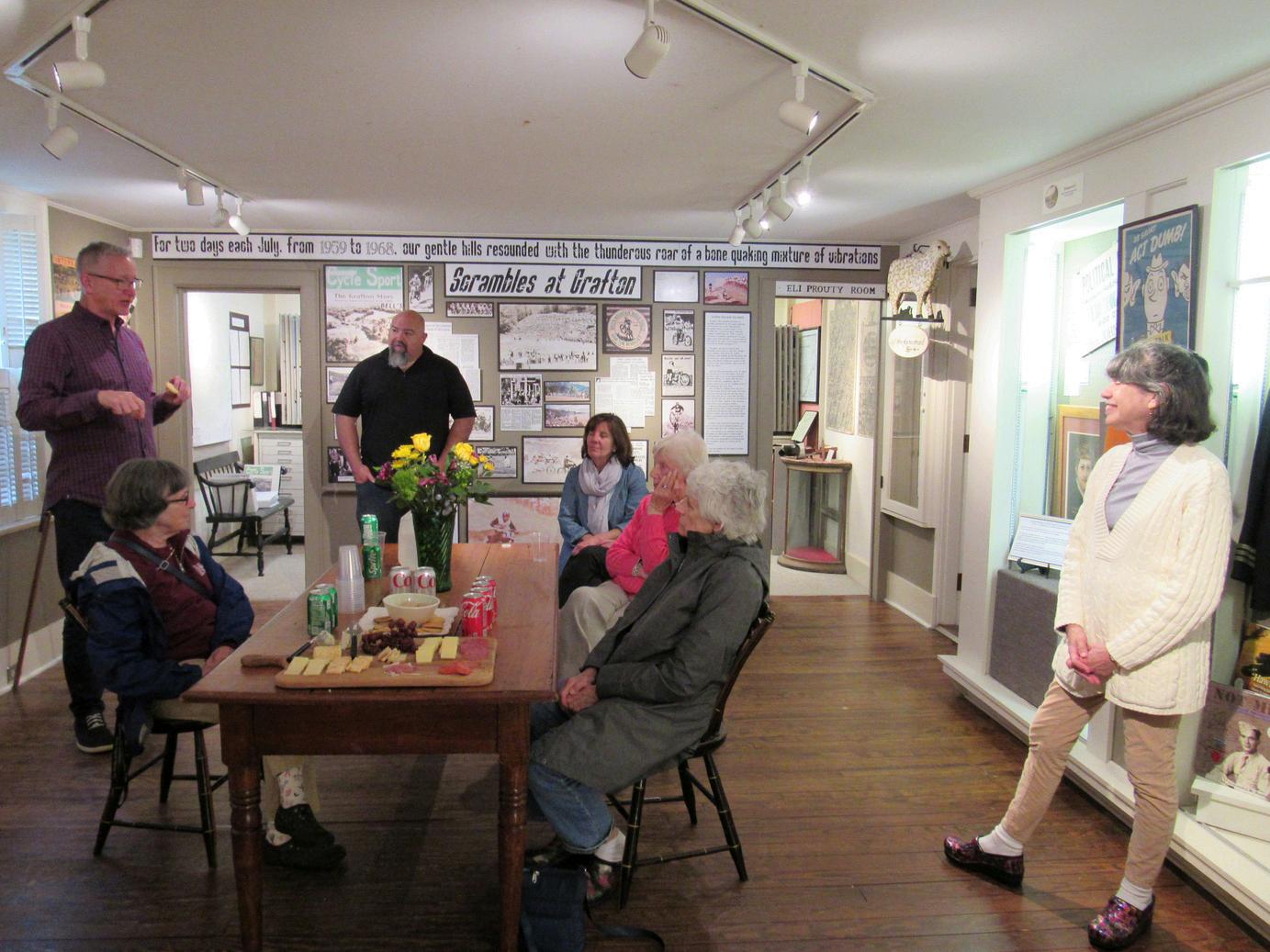
Park University’s Frances Fishburn Archives and Special Collections recently received acquisitions that reflect the lives of former Park students If individuals are interested in donating artifacts related to Park College (1875-2000) or Park University (2001-present), please contact the Fishburn Archives at archives@park edu
The Frances Fishburn Archives and Special Collections provides access to its collections as an unaltered, historical record. Some collection materials include images or words that are offensive. We do not support or condone these harmful ideas, and we embrace a culture that prioritizes diversity and inclusion. We make these items available because they are critically important resources for education and research, while acknowledging their impact on various peoples and groups.
Alan Smith, son of Dr. Harold Smith, ’44, donated a V-Mail written by Pvt. Wallace D. Wood (1924-98) who was serving with the 80th Chemical Company Selection Group (CML CO SG) during World War II V-Mail, or Victory Mail, was a means for servicemembers to have a secure method of corresponding from stations abroad V-mail would be censored, copied to film, and printed back on paper upon arrival at the destination Wood, also a member of the class of 1944, returned to Kansas City following the war and was engaged in the printing and advertising business He married Helen Blair, ’44, and the couple eventually settled in Rogers, Ark

ely chiefly on the quality of the ther than on elaborate preparation nd dishes vary by region Many dishes e regional, however, have proliferated with variations throughout the country
June 22, 1945
Hi Smitty, you old so and so,
Cheese and wine are a major part of the cuisine, with many variations and Denominazione di origine controllata (DOC) (regulated appellation) laws
I got your V-Mail last nite so I will sit down and answer it right now Boy! Will miracles never cease! I got a V-Mail from Hank last tie [nite] too [1] The guy seems to be very happy, in his own cute way If you get what I mean
I’m in a new job for a short time now Check this: I’m working in an office I must be a fine-looking specimen behind a desk The work is easy Mostly filing, typing, and looking pretty Wait a moment while change my powder
In case you didn’t know, I am now in Chateau Thierry, France [2] Maybe I will have some fun in Paris soon Don’t look at me like that, you know I am a good boy
The mail is so screwed up since we moved from Germany that I haven’t heard from Helen since about two weeks ago I’m afraid she is expecting my return a little too much I personally don’t see much hope for it for some time But who knows, you never can tell what this army will do As an example, I made a 100-mile trip yesterday to pick up one toilet and seat So that when the officers have a party tonight the women will have a place to piss What a life I think I would make a better civilian than a soldier
I’m sitting here with a big cigar in my mouth enjoying myself, the first cigar I have had in six months Tastes pretty good.
There is just one consolation to this sitting around. If I stay here long enough, I may not have to go to the Pacific. At least it puts it off for a while. That is one place I really don’t want to go. The mosquitos are too big.
I guess I better knock it off now. Good, good, take it easy and write soon.
Ever, Docs.
Endnotes
[1 ] Reference to Henry “Hank” Dearing Llewellyn (1921-2002) Llewellyn would have graduated in 1944; however, he left Park College in 1943 to join the U S Navy where he was a pilot and flight instructor He served on the USS Missouri
[2 ] Château Thierry is located between Paris and Reims During the summer of 1918, the German army was repulsed by the 4th Marine Expeditionary Brigade which prevented the German army from opening the road toward Paris and freed Château-Thierry by fighting into “Belleau Wood ” The town was occupied during World War II by the German army from June 1940 until August 1944 when it was liberated by the 7th Armored Division
The McManis family has donated a Zora Mantie (Wilson) McManis (1883-1949) diary that she maintained from 1906-07 while teaching at Grassy Cove Academy in Tennessee. The McManis and Wilson families had a long, early connection to Park College. Zora’s father, Samuel Fackler, was one of the “Original 17” that left Highland (Kan.) College in 1875 with Dr. John A. McAfee to establish Park College. Fackler left Park College before graduating for the ministry but returned to Parkville in 1900 where he resumed his studies at Park and graduated in 1906 with Zora and his son Lester.

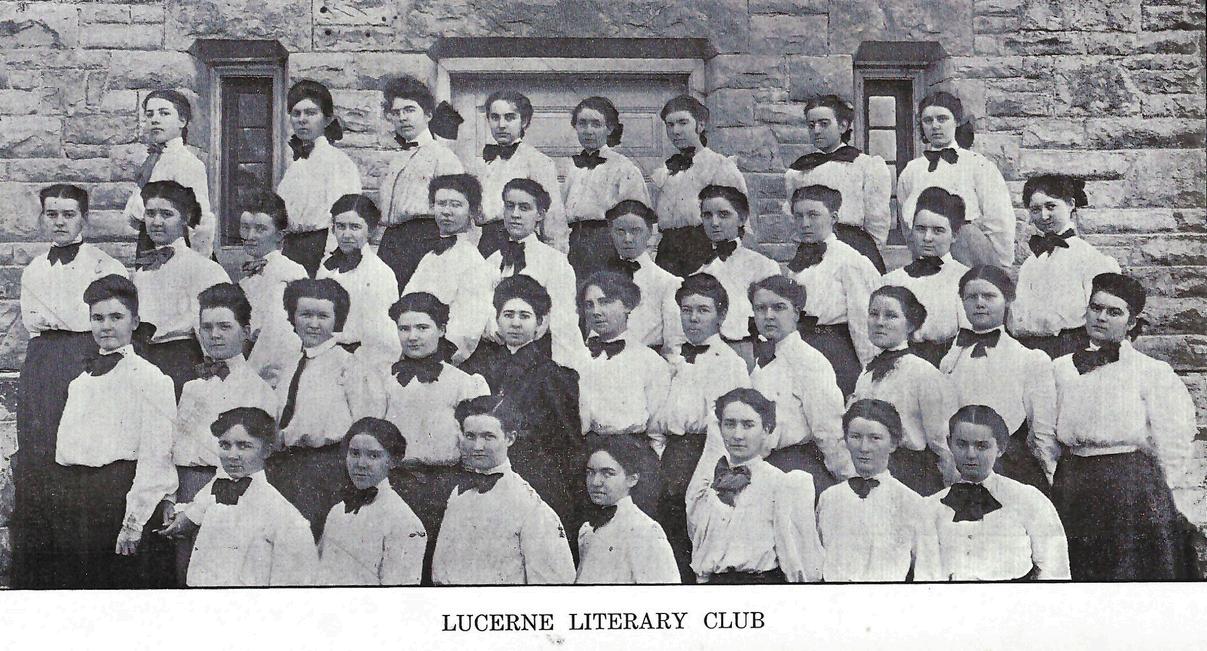
Zora attended Park College Academy and Park College, graduating in 1906 She was a member of the Lucerne Glee Club, college choir, served as a church pianist and as secretary of her sophomore class In 1901, Zora met Jay Wilbur McManis, Class of 1905 McManis’ older brother, Charles Neriah, was an 1898 graduate of Park College, and his sister Stella was an Academy classmate of Zora McManis taught mathematics at Park College Academy in 1906, before accepting a principal position at the Indian Mission School in Anadarko, Okla , eventually returning to Kansas City, Kan , in 1909 to teach mathematics
Grassy Cove Academy was established by the Presbytery of Kingston in 1884 to promote Christian education among the people of the Cumberland plateau
Jamie Jones, collection manager at the Butler County (Pa ) Historical Society, recently acquired a donation which contained over 50 early 20th century Park College postcards. The postcards were outside the scope of the BCHS collections, so Jones donated the collection.

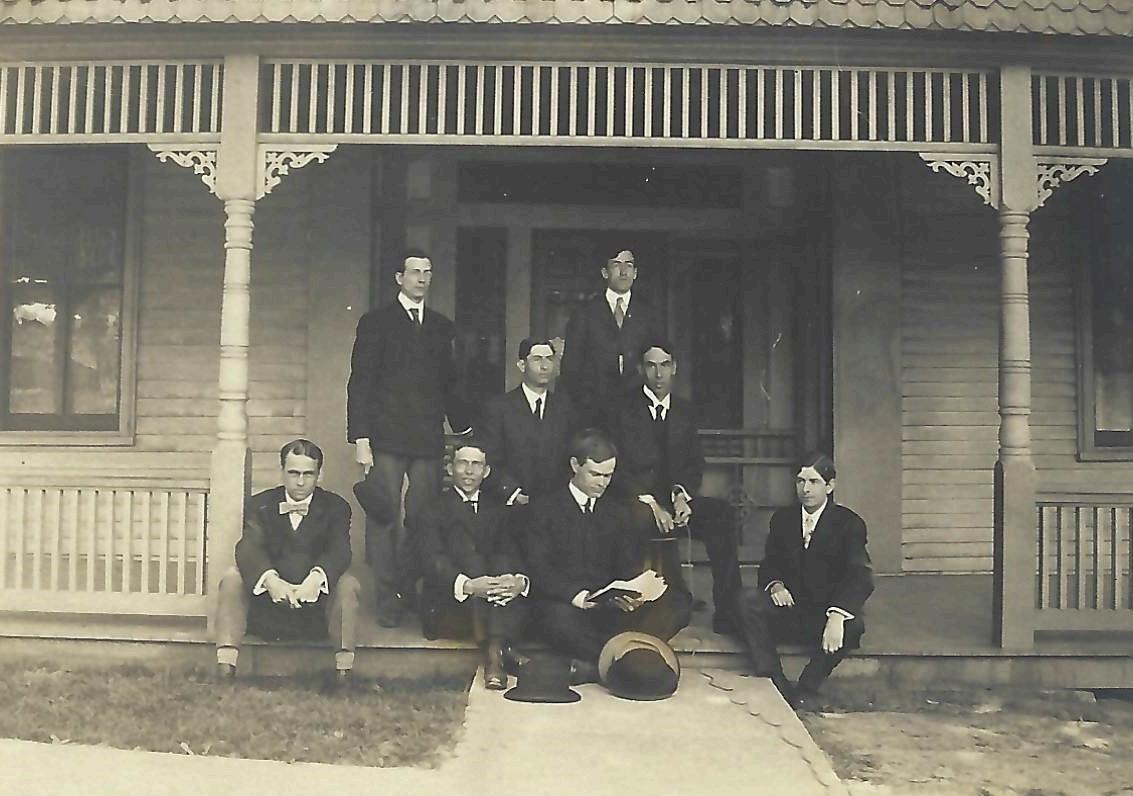

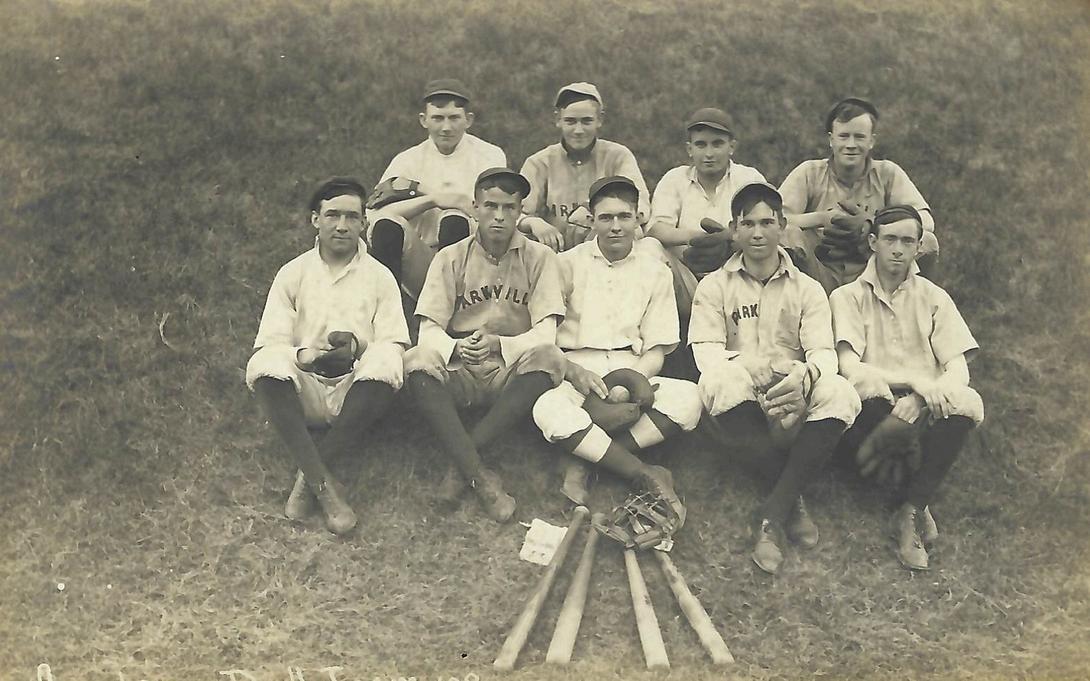

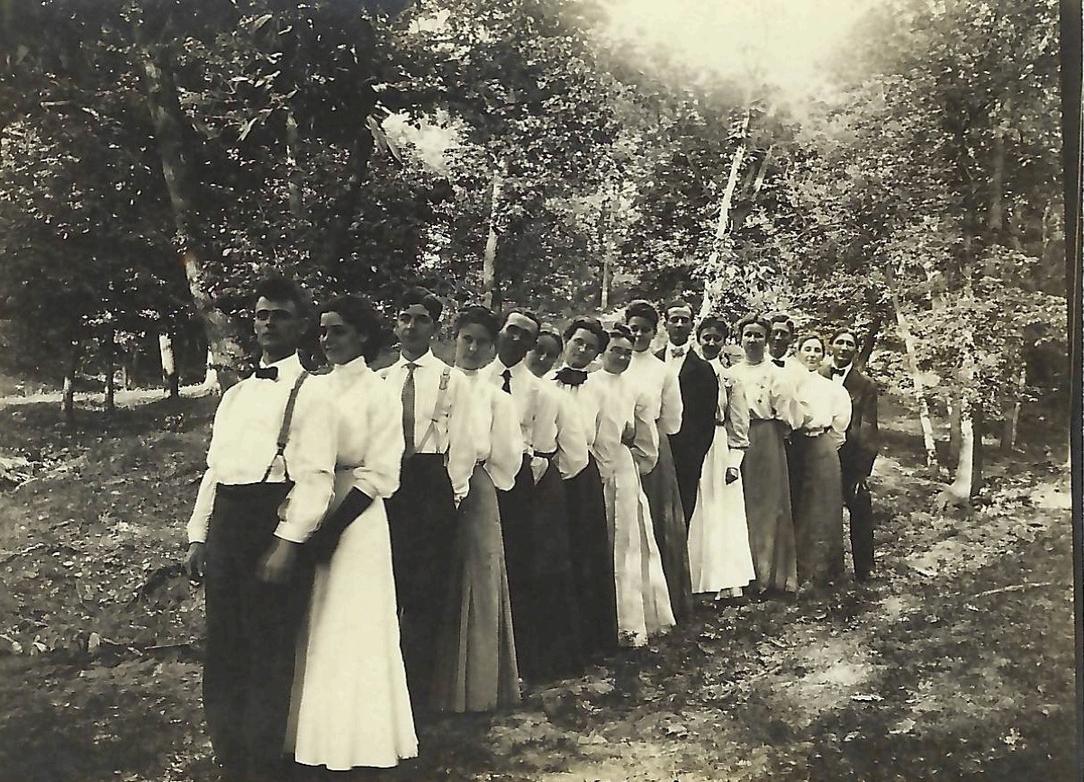
One of the postcards donated to Park University’s Frances Fishburn Archives and Special Collections by the Butler County (Pa.) Historical Society was the visit of William Jennings Bryan (1860-1925) to Park College in 1908. Bryan, born in Illinois, moved to Lincoln, Neb., in 1887. His initial education was home-schooled, but he would attend Whipple Academy and Illinois College, both in Jacksonville, Ill., and Union College of Law (currently Northwestern University Pritzker School of Law) in Chicago.

Bryan served as the commanding officer of the 3rd Nebraska Volunteer Infantry Regiment, Seventh Corps, from July 1898 to April 1899, as part of the occupation force in Cuba following the Spanish-American War. Bryan’s political career included serving in the U.S. House of Representatives (1891-95), U S Secretary of State (1913-15), and the Democratic Party presidential candidate in 1896, 1900 and 1908 Bryan was defeated in the 1896 and 1900 elections by William McKinley, and in the 1908 election by William Howard Taft
During the 1908 presidential campaign, Bryan missed train connections at Kansas City’s Union Depot back to Lincoln Due to the missed connections and a long-standing invitation, Bryan decided to make an impromptu visit to Park College
The Park College Record of March 1908 described Bryan’s visit:
“We were ready for him and we gave him a regulation college welcome College faculty, students and people of the vicinity were all out to hear him He spoke for an hour and a quarter, not on politics, but something larger and more important His subject was, first, oratory: ‘The man and his message, ’ and secondly, he spoke on ‘Faith,’ or, we would say, the elements that win. Mr. Bryan sets forth high ideals of life. He is large of heart. The whole human race is within his vision. He thinks of the world and for the world. The burden of the common people weighs down upon his shoulders. He listens to their cries. He knows their needs. He becomes one to use all human instrumentality to uplift and ennoble. He loves man. Upon his heart he bears the youth of America. After his speech he shook hands with every man, woman, and child white and black who approached him for that purpose. He stood among the college boys for his picture. His presence and speech were an inspiration to the whole college circle.”
The Platte County Gazette of March 5, 1908, wrote the following:
“The students of Park College and the people of Parkville were given a genuine treat when William J Bryan made them a long promised visit and addressed them in McCormick’s chapel The news of his coming was soon heralded abroad, and when he stepped upon the platform at 1:30, the large chapel building was packed His address was a great argument for proper and complete educ (education), for right living, and for the highest possible type of citizenship He was driven about the campus, and he everywhere manifested deep interest in the work of the college He was entertained at supper by Mr and Mrs Howard B McAfee ”
McAfee, writing in The Platte County Gazette in December 1908, furthered detailed Bryan’s visit:
“He [Bryan] was specially interested in the idea that students could so nearly earn their living while going to school and their activities become a part of the educational pursuit, instead of subtracting from it When letting me know of his proposed call Mr Bryan said it was not a political call, but to see the farm and other means of converting student labor into ‘self-support.’ He was at that time one of the biggest frogs in the political puddle
and I knew some of my democratic friends would feel like scalping me if they were not given a chance to meet him personally Mr Bryan, needing to shave and put on fresh linen, asked me to remain with him in the bedroom while he did so. He took that opportunity for a searching interrogatory into the whole theory of the ‘Open Door’ and the means of achieving it. I told him of the group I wanted him to meet. He urged that we make it short, as he wanted to see the farm and industries. We did make the reception short and got away, in the buggy to a farm and inspection trip He could appreciate our livestock assets as he was raising blooded cattle on his farm near Lincoln A few weeks later he sent us one of his best young bulls, to improve our stock cattle herd I admired Mr Bryan greatly but did not vote for him at either of the three elections he sought the Presidency of the United States ”

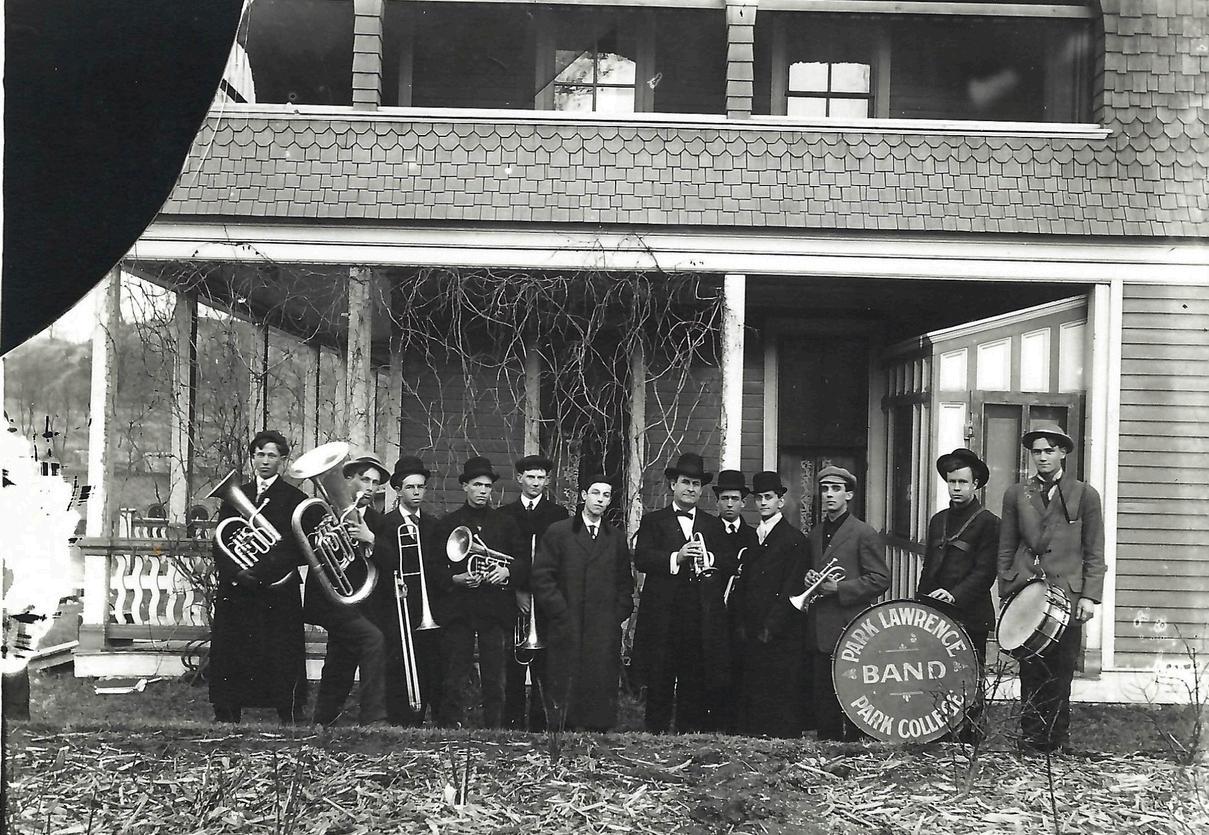
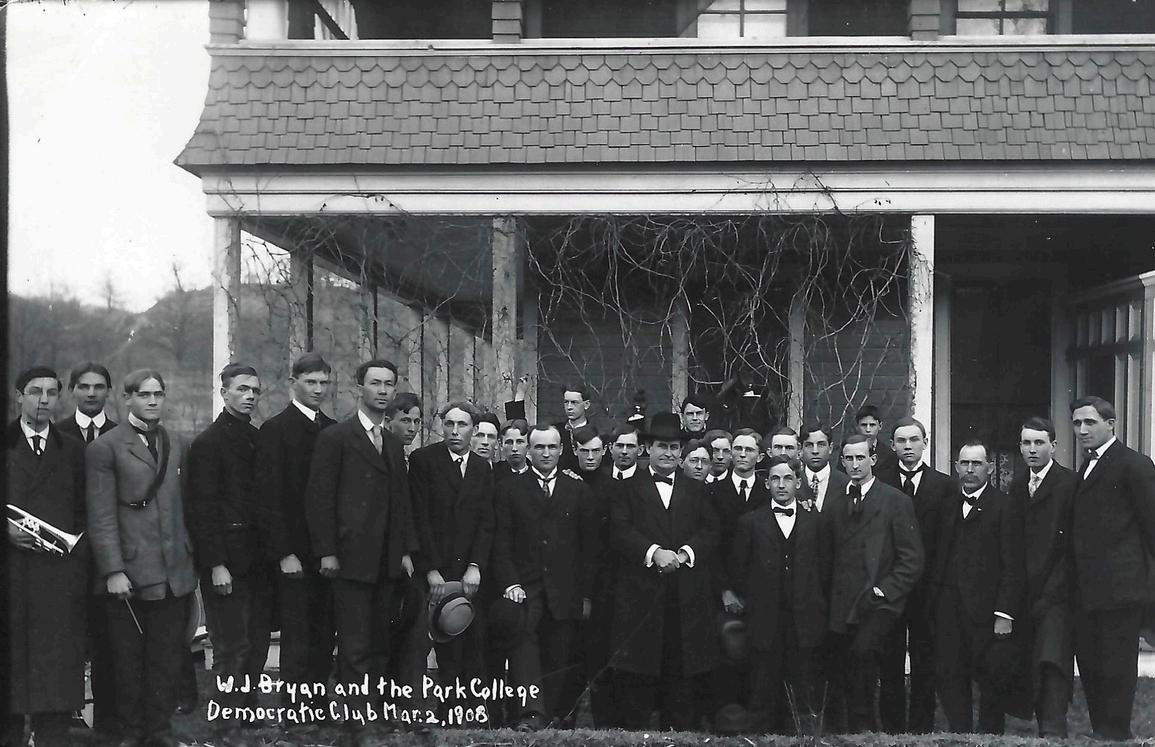

Seventy years ago, Park University had the occasion to be one of 131 higher education institutions across the country that enrolled 125,000 sailors in the V-12 Navy College Training Program [1]
In May 1943, Rear Adm Randall Jacobs, chief of the Bureau of Naval Personnel, said that the purpose of the V-12 Program was “to give prospective naval officers the benefits of college education in those areas most needed by the Navy We desire--to preserve the normal pattern of college life We are contracting--for the highest teaching skill, the best judgment, and the soundest administration of which the colleges are capable We desire--the best undergraduate education the colleges can offer ” [2]

The Park Stylus announced on Jan 8, 1943, that the Park University (then Park College) administration had returned a questionnaire to be selected for the “ purpose of furnishing prescribed instruction, housing and messing facilities for prospective officers ” [3] On Feb 28, 1943, the Joint Committee for the Selection of Non-Federal Educational Institutions published a list of institutions tentatively approved, including Park University, as one of the educational institutions to train sailors [4]
The tentative approval and a two-day visit by a U.S. Navy inspector had the University's administration scrambling to identify campus repairs and betterments to meet Navy unit requirements. [5] The identified list included athletic fields and drill grounds, dormitories, gymnasium, swimming pool, the bridge to Chesnut Hall, Thompson Commons and Mackay Hall, the dairy operation, printing press, and general campus grounds estimated at $97,000 (present cost would be $1.7 million). [6]
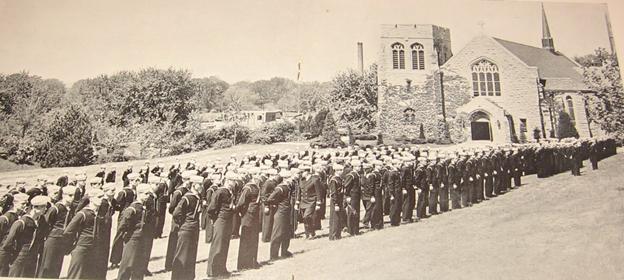
In early April 1943, the Navy informed Park University President William Lindsay Young, that the college had been selected as a V-12 Program institution and that the first 270 trainees would arrive on the Parkville, Mo , campus on July 1, 1943 [7] The trainees, immediately upon arrival, encountered some unforeseen circumstances First, the University had only months previously announced offering a summer session, which had never before been an option. [8] Second, the summer session created a manpower shortage of faculty and staff. [9] Third, though the Navy furnished towels, the shipment was late, so the War Mothers of Parkville and the local Red Cross unit assisted. [10] Fourth, when uniforms arrived, they did not fit all the trainees. Again, Red Cross volunteers sewed necessary uniform alternations. [11]
The initial 270 trainees, plus an additional 130 by mid-October 1943, were dispersed among the dormitories of Chesnut, Copley-Thaw, Sunset, and Woodward. [12] The senior trainees, those with prior military service, resided in Copley-Thaw Hall. By mid-1943, 25 had already experienced the horrors of war including being blown off a repair ship tied next to the USS Arizona; battleship and submarine duties in the Pacific; landmine duties off Guadalcanal and Munda in the Solomon Islands; and Seabee and destroyer duties in the Aleutians Islands [13] The experiences of these two dozen senior trainees helped the V-12 program officer corps instill in other trainees the gravity of their education and training
The initial officer corps was composed of Lt Harry Willard Reninger (1900-88), commanding officer; Lt (Junior Grade) William Richard Gondin (1912-95), executive officer; Lt Cmdr Arthur Friedrich Loeffler (1911-2002), medical officer; and Lt j g Earl Elburn Bartlett (1908-87), personnel and athletic officer; [14] Lt j g Edward Joseph Kawal (1906-60) replaced Bartlett in December 1943, [15] Lt j g Winchester Hallock Heicher (1908-87) replaced Gondin in March 1944, [16] and Lt Roscoe Schiele Yagerlehner (1904-89) replaced Loeffler in November 1944 [17]


The officer corps set an example that military service could be attained alongside academics. Gondin’s philosophical work Preface To Inquiry, A Study in the Origins and Relevance of Modern Theories of Knowledge had been published by Columbia University Press shortly before his arrival at Park University. [20] Heicher addressed the Philosophy Club during the summer of 1944 with a presentation titled “Observations on the Nature of Political Control.” [21] Three weeks after V-E Day, Reninger addressed the Park University community with a lecture titled “Humanities, Democracy and Poetry,” focusing on the works of Walt Whitman and other poets that represented democratic trends and opposing forces. [22]
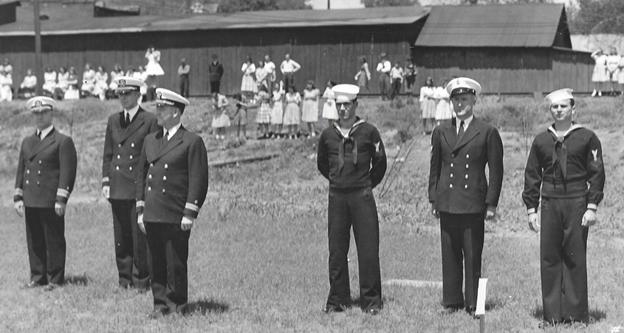
Young addressed the summer and incoming trainees in mid-August 1943, acknowledging the previous circumstances the summer trainees had confronted saying “We appreciate your patience and good humor in these first weeks of adjustment” and assured the trainees that “We will soon be adequately organized and equipped to serve your needs.” [23] An expectation for both the civilian and military administrations was Young’s invitation for the trainees “to participate as fully as your time and duties will permit in the social life of Park.” [24]
In response to Young’s invitation, Reninger replied “Our ship’s officers would be disturbed to discover that the civilian and the Navy students were not welding themselves into one social group; ” however, Reninger pointed to two factors limited time and Naval security for trainee involvement “The V-12 Program must be accomplished-in the shortest possible time which is consistent with thoroughness” and “Naval personnel must be made secure, that is safe from disabling accident and chance ” [25]

The civilian and military administrations, however, understood that students and trainees were attending college and hoped to participate in the general academic, social clubs, and social life of Park University [26] The first test of the social understanding occurred in late August 1943 at the Kansas City USO dance during which Bartlett commented that the dance’s success “indicated that similar functions would be on tap for Park in the near future ” [27] Both groups of students held numerous other joint events including variety shows The trainees participated in Phalanx services and organized their own Navy choir and color guard [28]

Participation in athletics came to the forefront in November 1943, when the V-12 Program trainees, who in large part had participated in high school or collegiate athletics prior to attending Park University, desired “participation in all competitive sports ” [29] Following discussions between the civilian and military administrations, trainees were permitted to participate in inter-barracks or inter-collegiate athletic competitions of baseball, basketball, boxing, cross-country, football (intramural), soccer, softball, swimming, track, and volleyball [30]


Between July 1, 1943, and March 1, 1945, 825 V-12 Program trainees attended Park University [31] By the spring of 1945, the European war was drawing to a close and there was a real possibility that the Bureau of Naval Personnel would discontinue the V-12 Program [32] Park University’s civilian administration, in consultation with the faculty, recommended a return to a two-semester schedule versus the accelerated three-semester schedule instituted since July 1, 1943 The administration agreed saying “Park--faces the future with confidence The past two years has been a critical period It has tested severely the ability of the college to make difficult adjustments rapidly, to meet the needs of the Navy V-12 unit with regard to changes in curricula, teaching staff,and physical equipment Park--has contributed generously and effectively in the support of our country at war Many of the graduates and former students hold important key positions in the service of the country Many have already made the supreme sacrifice ” [33]
Rear Adm. William M. Fechteler, assistant chief of Naval personnel, wrote, “I wish to take this opportunity to express--the appreciation of the Department for the assistance your institution has tendered in the training of officer candidates for the Navy. By participating in the V-12 Program, Park--has made an important contribution to the war effort of the Navy.” [34] The U.S. Navy, in 1947, presented a bronze plaque to Park University, currently on display in Mackay Hall, for participation in the V-12 Program. [35]
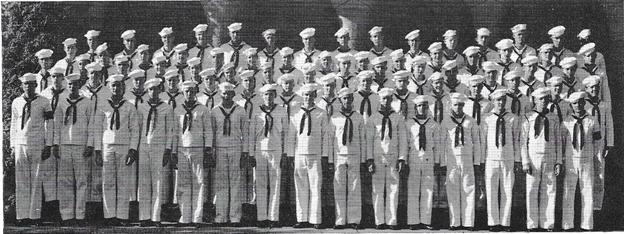
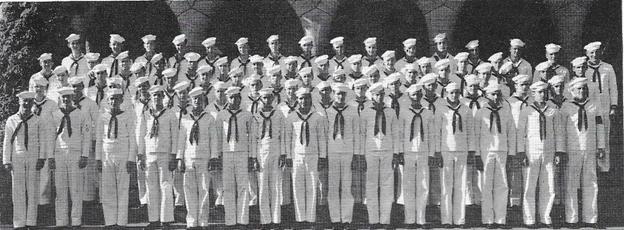

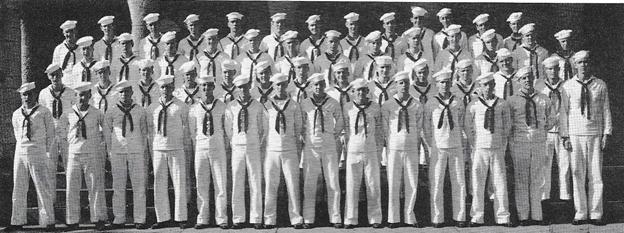



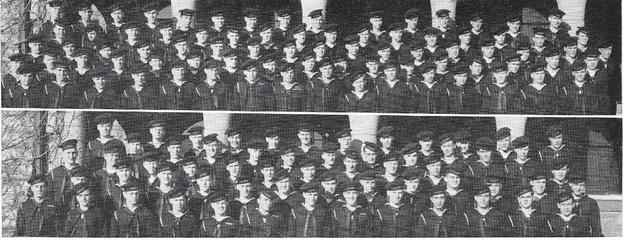
The trainees arrived on the banks of the Missouri River from every corner of the nation--a nation at war on two geographical and ideological fronts Park University was very proud to have served these V-12 sailors and remains committed, as more than a century of service acknowledges, to rendering our duty to every servicemember in need and our nation when called

View some 16mm film from the archives on Navy V-12 Program at https://youtu be/T-Fr5E qpsI or by scanning the QR Code

[1] Park University was one of seven liberal arts/teacher colleges, three dental schools and three medical schools in Missouri
[2] “The Navy V-12 Program,” Journal of the American Association of Collegiate Registrars 19, No. 2 (January 1944): n p Frances Fishburn Archives and Special Collections
[3] “Navy May Train Here,” The Park Stylus (Parkville, Mo.), January 8, 1943. Frances Fishburn Archives and Special Collections
[4] “Park Gets Tentative V-12 O K , ” The Park Stylus (Parkville, Mo ), March 5, 1943 Frances Fishburn Archives and Special Collections. The selection was not the first occasion in which Park University trained servicemembers for the U S military In 1918, Park University was one of 157 educational institutions selected for the Student Army Training Corps to educate and train U.S. Army trainees during World War I.
[5] “Navy Makes Inspection,” The Park Stylus (Parkville, Mo ), March 12, 1943 Frances Fishburn Archives and Special Collections
[6] “Navy V-12 Unit Requirements: Buildings, Grounds, Equipments, Repairs and Betterments,” Undated. Frances Fishburn Archives and Special Collections According to The Park Stylus, April 9, 1943, “In preparation for the arrival of the Navy Unit, the floor of the conservatory will be taken up, and the old swimming pool will be put in shape for use A serious shortage of water in 1914 caused the pool to be closed, and it has not been used since ” Frances Fishburn Archives and Special Collections.
[7] “Navy Men to Train Here,” The Park Stylus (Parkville, Mo ), April 9, 1943 Also see, “The Navy Comes to Park,” The Park College Record (Parkville, Mo ), June 1943 Frances Fishburn Archives and Special Collections
[8] “Summer Session Planned,” The Park College Record (Parkville, Mo.), March 1942. Frances Fishburn Archives and Special Collections
[9] “News From Park,” The Park College Record (Parkville, Mo.), October 1943. Frances Fishburn Archives and Special Collections Also see, “A Message,” The Park Stylus (Parkville, Mo ), August 13, 1943 Frances Fishburn Archives and Special Collections
[10] Ibid.
[11] Ibid
[12] “Navy Men to Train Here,” The Park Stylus (Parkville, Mo.), April 9, 1943. Frances Fishburn Archives and Special Collections Also see, “Addresses Made for Navy V-12 Welcome,” The Platte County Gazette (Parkville, Mo ), October 8, 1943. Frances Fishburn Archives and Special Collections.
[13] “Men of the Fleet at Park College Have Seen Action on Mo ), October 1943 Frances Fishburn Archives and Special Collections
Harry Willard Reninger was born on March 20, 1900, in Youngstown, Ohio He earned his Bachelor of Arts, Master of Arts, and doctorate degrees in English from the University of Michigan. His early academic career was at a high school in Detroit prior to going to Michigan State Normal College (now Eastern Michigan University) and back to the University of Michigan before arriving at Iowa State Teachers College (now the University of Northern Iowa) in 1939. Shortly following his arrival at ISTC, he became chair of the English Department In 1943, Reninger was granted a leave of absence to serve in the U S Navy His works were published in American Literature and American Schoolmaster, as well as several textbooks. He was a member of the Modern Language Association of America, the National Council of Teachers of English and the American Association of University Professors. He served as vice president (1941-42) and president (1946-48) of the Iowa College Conference on English
William Richard Gondin was born on August 28, 1912 He earned his Bachelor of Arts degree in mathematics and a doctorate degree in philosophy from Columbia University. He taught speech at The College of the City of New York and at the Seth Low College of Columbia University where he served as director of student activities Gondin was commissioned in May 1942 from Columbia’s Midshipmen School Following commissioning, he was assigned to teach ordnance gunnery and ballistics at the Brooklyn (N.Y.) Navy Yards. He published 26 works on mathematics, public speaking, theories of knowledge, and parliamentary procedures. Gondin died on Oct. 29, 1995, in Maine.
Arthur Friedrich Loeffler was born on June 20, 1911, Bumflingen, Germany. Following his military service, he settled in Fort Wayne, Ind , where he was an assistant brewmaster with Hoff-Brau Brewery and custodian for the Fort Wayne Community School District He died on March 19, 2002, in Fort Wayne
Winchester Hallock Heicher was born on June 1, 1908, in Nagasaki, Japan, the son of a Methodist missionary After moving to the U.S. in 1911, Heicher attended school in Cedar Falls, Iowa, and Corvallis, Ore., attending the University of Oregon until 1929 Heicher transferred to Stanford University, where he earned a degree in history in 1930 After graduation, he taught history and political science at New York University, University of Miami, Hunter College and the University of Vermont, where he wrote and published "Democracy in England" (1939, The American Scholar), a review, "Europe on the Eve", Frederick L Schuman (1939, The Annals of the American Academy of Political and Social Science), and a second review, "International Boundaries " , S. Whitmore Boggs (1940, The Annals of the American Academy of Political and Social Science) By the time of his registration with the selective service in 1940, Heicher had married Joyce Helen Powers in New York. In 1944, he attended the V-12 Officer’s Program at Park College (now Park University), where he was a lieutenant junior grade and by 1951, a lieutenant Heicher continued to teach and author around the country, publishing a review to "The World’s Iron Age", William Henry Chamberlin (1942, The Annals of the American Academy of Political and Social Science) and "The New Europe: An Introduction to Its Political Geography " , Walter Fitzgerald (1947, The Annals of the American Academy of Political and Social Science). Heicher and his wife lived in Rio de Janeiro and Sydney where he taught at various universities until his death in December 1987 at the U S Consulate in Sydney
Earl Elburn “Tex” Bartlett was born on Dec. 16, 1908, in Purcell, Okl. He attended Centre College in Danville, Ky , earning a Bachelor of Arts degree in physics He was also a noted fullback on the football team and captain of the basketball and track teams. He played professional football, as a halfback, for the Boston Shamrocks (1936-37), Cleveland Rams, Louisville Tanks, and Pittsburgh Pirates (1939) He led the league in scoring (1936-38) and was a member of the all-star professional team in 1936 and 1937 Following his season with the Pirates, he returned to Oklahoma and coached high school football. He went back to Danville, following World War II and was an educator Bartlett died on Jan 26, 1987, in Danville
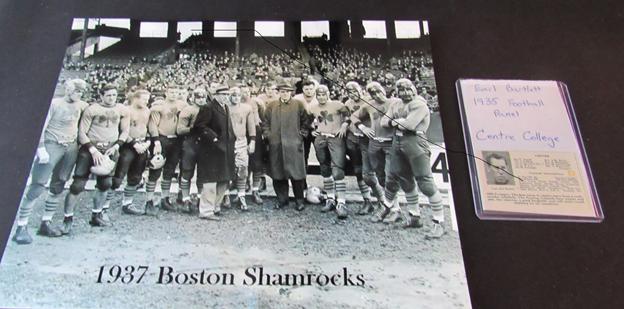
Earl Bartlett Center (Second Individual to the Right of the Coach on Left) V-12 Navy College Training Program, Frances Fishburn Archives and Special Collections, Park University, Parkville, Missouri
Edward Joseph Kawal was born on Oct 13, 1909, in Cicero, Ill He attended the University of Illinois, Pennsylvania Military College, and Widener College. Following college, he played professional football, as a center and offensive lineman for the Chicago Bears (1931-36) and Washington Redskins (now Washington Commanders 1937) He died on Sept 25, 1960, in Oak Park, Ill

Edward Kawal – No 19 1934 Chicago Bears – Division Champs and Matchbook Cover V-12 Navy College Training Program, Frances Fishburn Archives and Special Collections, Park University, Parkville, Missouri

1935 Chicago Bears
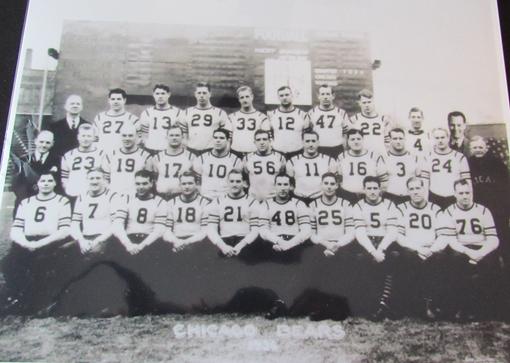
1936 Chicago Bears – Division Champs
Roscoe Schiele Yegerlehner was born on Nov 25, 1904, in Clay City, Ind Following high school, he taught in rural schools In the early 1930s, he began the study of medicine at Indiana University, Bloomington, graduating in 1938. Yegerlehner and his family moved to Kentland, Ind., and he established a medical practice. He joined the U.S. Navy in 1942 and remained there throughout the war, returning to Kentland to continue his medical practice for another 28 years. In 1973, he moved to West Lafayette, Ind., to work in a teaching hospital. Yegerlehner died on Aug. 28, 1989, in Sarasota, Fla.
[15] “V-12 Officers Leave Station,” The Park Stylus (Parkville, Mo.), December 3, 1943; “Replacements Assume Duties For Naval Unit,” The Park Stylus (Parkville, Mo.), January 7, 1944. Frances Fishburn Archives and Special Collections.
[16] “Lt W Heicher Joins Naval Staff,” The Park Stylus (Parkville, Mo ), March 24, 1944 Frances Fishburn Archives and Special Collections
[17] “New Medical Officer Joins Naval Staff,” The Park Stylus (Parkville, Mo ), November 17, 1944 Frances Fishburn Archives and Special Collections The last name was misspelled in the article Yegerlehner
[18] “Special Spring Term Edition of the Park Stylus,” The Park Stylus (Parkville, Mo ), June 16, 1944 Frances Fishburn Archives and Special Collections
[19] “Special Edition,” The Park Stylus (Parkville, Mo ), February 1945 Frances Fishburn Archives and Special Collections
[20] “Navy Officer Writes Book On Philosophy,” The Park Stylus (Parkville, Mo ), September 24, 1943 Frances Fishburn Archives and Special Collections
[21] “Lt. Heicher To Address First Philosophy Meeting,” The Park Stylus (Parkville, Mo.), July 14, 1944. Frances Fishburn Archives and Special Collections.
[22] “Reninger To Speak On American Poetry,” The Park Stylus (Parkville, Mo.), May 25, 1945. Frances Fishburn Archives and Special Collections.
[23] “A Message,” The Park Stylus (Parkville, Mo.), August 13, 1943. Frances Fishburn Archives and Special Collections.
[24] “One Plus One Equal One,” The Park Stylus (Parkville, Mo.), August 20, 1943. Frances Fishburn Archives and Special Collections
[25] Ibid
[26] “Navy V-12 Trainees Join Park’s Men’s Social Clubs,” The Park Stylus (Parkville, Mo ), September 1, 1944 Frances Fishburn Archives and Special Collections Also see, “Park Navy V-12 Trainees Join Men’s Social Clubs,” The Park Stylus (Parkville, Mo ), December 9, 1944 Frances Fishburn Archives and Special Collections The Social Clubs joined were Lowell, Orion, and Parchevard
[27] “Future Naval Dances Seen for Park Trainees,” The Park Stylus (Parkville, Mo ), September 17, 1943 Frances Fishburn Archives and Special Collections A farewell dance recognizing the first year of the V-12 Program was held on 9 June 1944 Also see, “Farewell Dance To Mark End Of Navy’s First Year at Park,” The Park Stylus (Parkville, Mo ), June 2, 1944 Frances Fishburn Archives and Special Collections
[28] “Navy Men To Lead Phalanx Service,” The Park Stylus (Parkville, Mo.), November 12, 1943. Frances Fishburn Archives and Special Collections; Also see, “Dr. Griffith Organizes New Park Navy Choir,” The Park Stylus (Parkville, Mo.), March 10, 1944. Frances Fishburn Archives and Special Collections. The Navy Choir sang at the weekly Navy Chapel Service; Also see, “Copley Unit Adds Dignity To Color Guard Detail,” The Park Stylus (Parkville, Mo.), July 14, 1944. Frances Fishburn Archives and Special Collections. [29] “New Navy Trainees Desire Competition,” The Park Stylus (Parkville, Mo.), November 19, 1943. Frances Fishburn Archives and Special Collections.
[30] “Inter-Collegiate Athletics Scheduled for V-12 Unit,” The Park Stylus (Parkville, Mo.), December 3, 1943; Also, see, “Naval Unit Arranges Its Spring Sports,” The Park Stylus (Parkville, Mo ), March 10, 1944 Frances Fishburn Archives and Special Collections The baseball teams were divided between the American League (Teams included from Chesnut: Blues, Gobs and Hot Dogs and from Woodward: Eager Beavers, Indians, Yanks, Reds, Woodchoppers, Tarmacs, and Dirty Sox) and National League (Teams included from Copley: Sluggers, Washouts, Cobras, Ramrods, Two-Toed Sloths, Dogs, Goldbrickers, and Jokers and from Nickel: Ugly Ducklings, Salts, and Nickelodians) The summer of 1944 volleyball and softball teams carried such names as Copley: Salts, Woodchoppers, Fusiliers, Hot Shots, Pick Ups, Esquires, Sluggers, Bandits, A P O , and Cobras; Chesnut: Rockets and Raiders; Asbury: Rockets; Nickel: Extra Duties, Liberty Hounds, and Restrictees; and Woodward: Blues, Ramblers, Reds, Dirty Sox, and Yanks; Also see, “V-12 Teams Begin Football Tourney,” The Park Stylus (Parkville, MO), September 22, 1944 Frances Fishburn Archives and Special Collections; Also see, “Special Spring Term Edition of the Park Stylus,” The Park Stylus (Parkville, Mo.), June 16, 1944. Frances Fishburn Archives and Special Collections.
[31] “Park’s Program for 1945-46,” The Park College Record (Parkville, Mo.), March 1945. Frances Fishburn Archives and Special Collections.
[32] Ibid.
[33] Ibid.
[34] “Park College Unable to Accept Navy V-12 Enrollment for Next Semester,” The Park Stylus (Parkville, Mo.), May 18, 1945 Frances Fishburn Archives and Special Collections
[35] “Bronze Plaque Given by Navy,” The Park Stylus (Parkville, Mo ), January 24, 1947 Frances Fishburn Archives and Special Collections
The Park Hill (Mo.) School District recently concluded its “Elementary 12” planning for a new elementary school in Parkville, Mo. During the early months of 2024, a group of parents, students, staff, and community members met to discuss the naming of the school In early February 2024, five names were presented to the Park Hill Board of Education and later that month, the Board unanimously approved the name Angeline Washington Elementary School
The reason the committee felt strongly about the choice of Angeline Washington is because a woman who was enslaved survived and gained freedom Then, she built a family and community within the area regardless of the barriers and challenges she faced as a woman and as a person of color during that time At the intersection of those identities was her ability to build a family and a community connected to others within the church and contribute to education, which is pivotal
Washington was born on the farm of William Campbell in Clay County, Mo On June 20, 1844, George S Park (cofounder of Park University) encountered Washington’s mother, who is distressed that she faces the loss of her daughter and pleads with Park to purchase Washington so not to be separated a long distance
“Know all men by these presents that I, William Campbell of Clay County, State of Missouri, have this day Bargained and sold and delivered and by these presents do bargain, sell, deliver, and confirm unto George S. Park of the county of Platte, State of Missouri, a certain negro Girl, a slave named Angelina, aged about nine years old to have and to hold her forever and I warrant said Girl Slave Angelina to be sound in body and mind and born a slave for life for and in consideration of the sum of three hundred and fifty dollars in hand paid the receipt of which is hereby acknowledged for the sale and warrantie above written.”
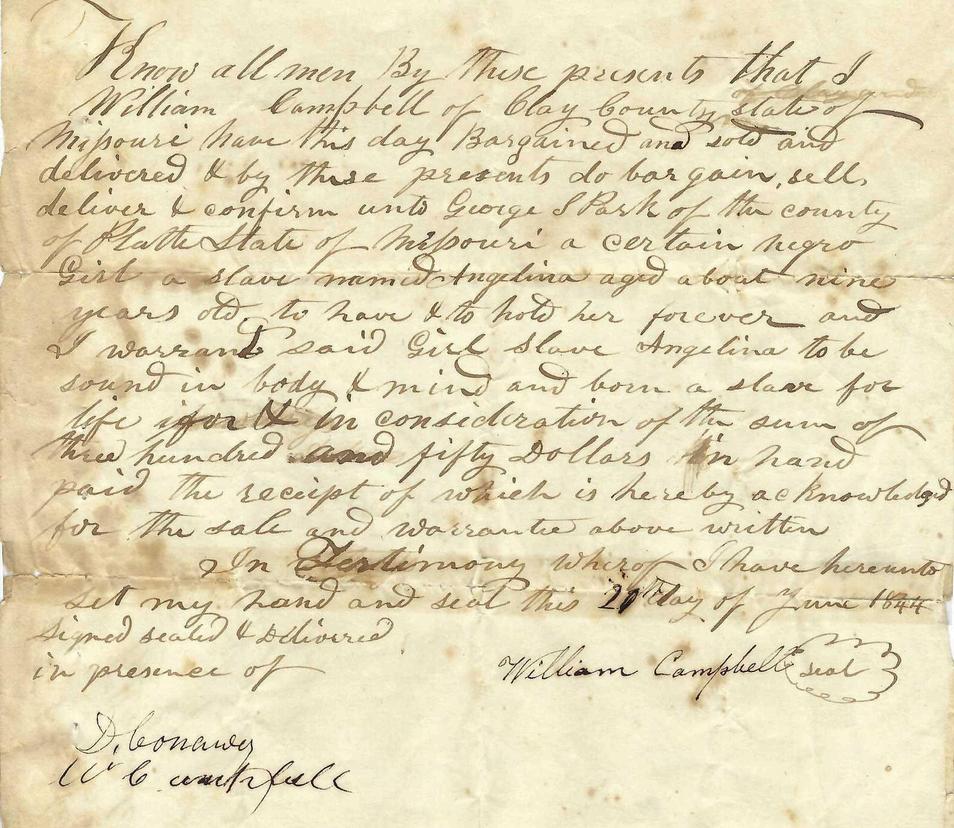

Platte County tax lists for 1847 and 1849, and the 1850 Federal Slave Schedule record Park’s ownership of Washington. During the early 1850s, Washington was manumitted by Park and in 1855 she marries William Washington although illegal by Missouri statute by the Rev. George Woodward of the Parkville Presbyterian Church where the Washington’s were members. William Washington, born in Pennsylvania after slavery was abolished in the state, appears to have been one of the free blacks residing in Weston, Mo., in the early 1850s. Evidence suggests that William was employed by Park. The marriage resulted in eight children born between 1856 and 1875.
The Washington’s resided on one acre of land, known as the William Washington Homestead, 1 5 miles east of Parkville Park deeds the property to the Washington’s in 1886 The property included a house and stable, space for a garden and fruit trees In 1895, the Washington’s moved to Parkville, and William leased the farmstead to Edward Slater
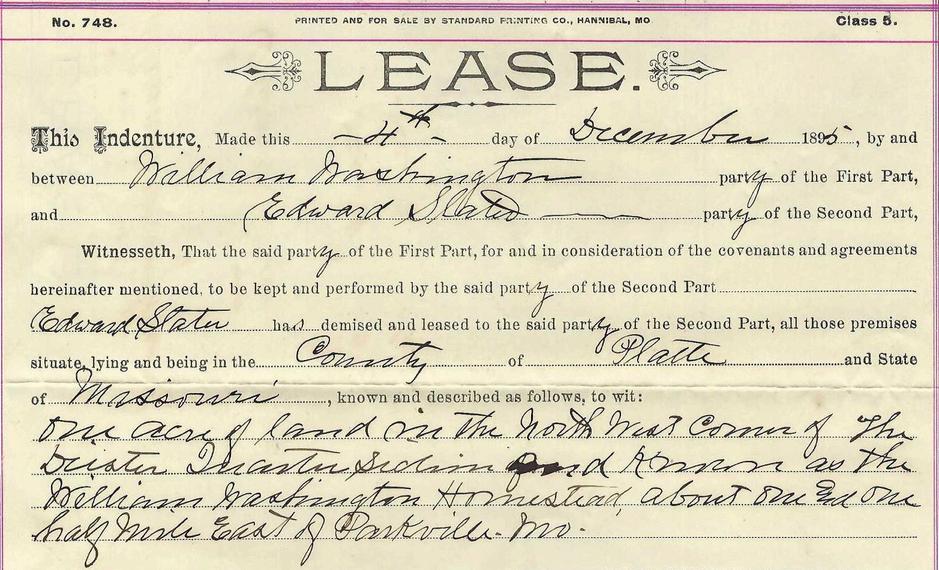
Mike Kimbrel, Ph.D., superintendent of the Park Hill School District, commented during the groundbreaking ceremony. “The naming committee wanted to express the story of Angeline through the perspective of her life as an enslaved woman to a freed woman who married, had children, pioneered educational and religious opportunity, and bonded a community. I believe we are measured by what we give. Angeline Washington gave everything. How we live matters. How you serve a community matters.”
The Washington’s were charter members of the Washington Chapel Colored Methodist Episcopal Church, in Parkville in 1870 The Angeline Washington Elementary School is the PHSDs first school named for a female and an African American

Global civilizations have been tested by diseases, epidemics and plagues for centuries. [1] Societies and officials have confronted these outbreaks by numerous measures some successful to protect their constituencies. The measures implemented could be controversial, but full and truthful communications became necessary in halting these outbreaks.
Park College (now Park University) has not been exempted from such outbreaks During the late 19th century, cases of diphtheria, mumps, measles, smallpox, scarlet fever, typhoid fever and routine seasonal diseases effected students, staff and faculty [2]
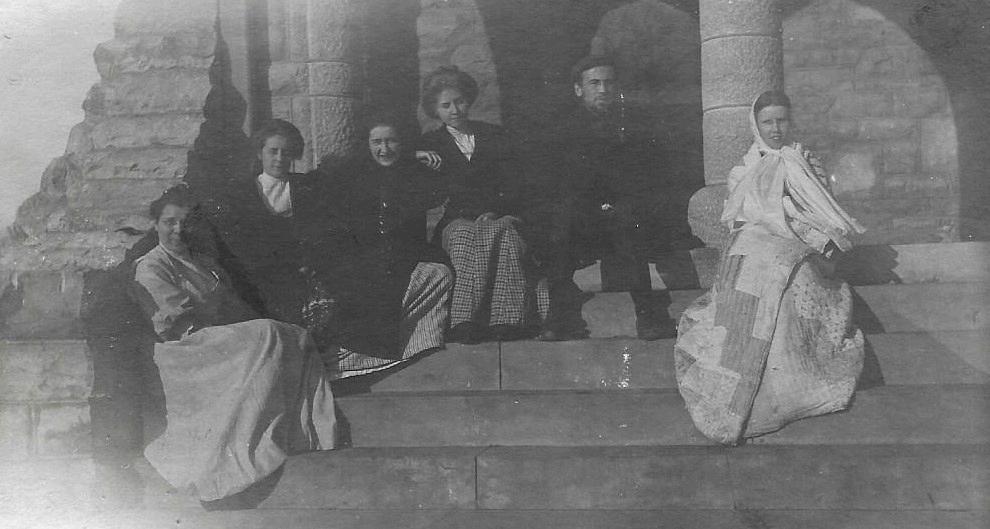
Scarlet Fever patients on Alumni Hall steps (c November 1908) The Typhoid Epidemic Collection, Frances Fishburn Archives and Special Collections, Park University, Parkville, Mo
Following the return of students in Fall 1909, some became ill and died Ill students were removed to their dormitory rooms, the college hospital or returned home Howard Worden Wylie, 1910 graduate, wrote about his experience The typhoid epidemic of 1909 and 1910 represented one of the worst outbreaks of disease at Park College, but also the manner which leadership communicated that epidemic within the larger college and greater communities.
There need be no question as to the cause of this very serious epidemic of typhoid. On the one hand, the ultimate cause was the love of the Missouri River to change its course and wander around over its bottom land. But the proximate cause was in part the conviction of one or two of the McAfee sons that each of them, like the father, “had a private wire to heaven.” [3] This made him always right, infallible. It was not necessary to consult with others or consider their opinions When I entered Park College, in September 1906, the Missouri was a straight, swiftly flowing river, from a point a mile above the station, to one well over a mile below it All the way it was
beside the railroad line By the summer of 1909, it did not come within a quarter of a mile of the railroad at any point What had been the channel going by the station and village was now a quiet pool, going up past the station and past the pumping station, the water entering it at both ends The lower end was where the sewer emptied into it The mixture drifted up past the pumping station, from which the water was pumped out into the college water system In other words, we were drinking our own sewage As a matter of fact, drinking water should never have been pumped out of such a pool When boiling the water had been started, it should never have been stopped until they had a new and safe course of supply They got this sometime later, by laying a pipe out to the main channel of the river But this was done too late to save us from the tragedy
Very soon after the College opened (for classes) in September 1909, an alarming number of students started coming down with typhoid fever Soon the entire college community became alarmed Many felt that the drinking water should be boiled, but the Administration delayed taking this step until there was very sharp criticism. Probably it was early in October that the policy of boiling all water for drinking was began. When this step was taken, at once, there were no more cases.
In September, with the considerable additions to the number needing service in the College Hospital, a new and much larger hospital was put into service. It was the house that had been occupied by the H.B. McAfee family, but that had just been vacated late that summer. It was later used as a girls’ dormitory and was called Gillette (sic). Two of my sisters lived in it, several years apart. The hospital took care of some fifteen to eighteen patients. Slightly more than half of those contracting the disease went to their homes. [4]
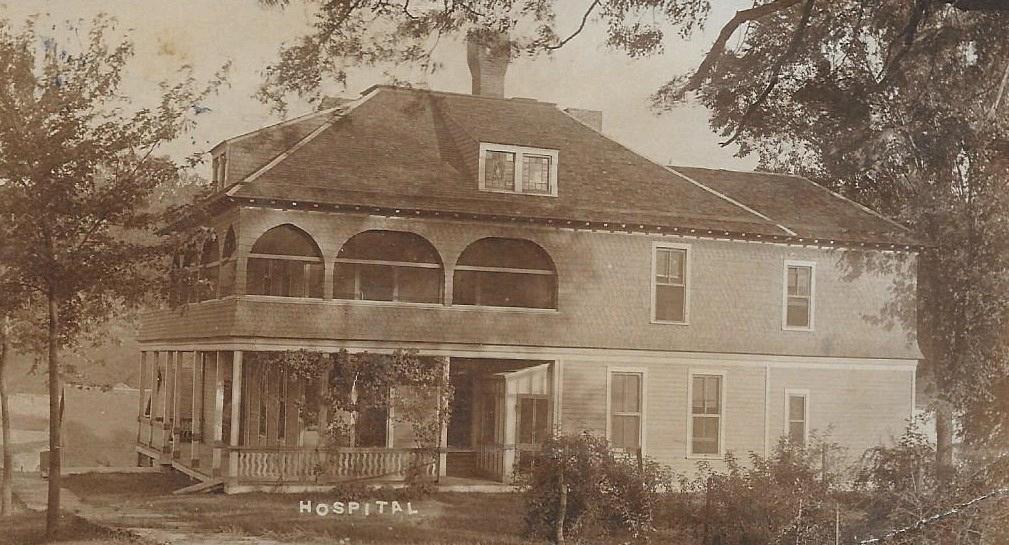
College Hospital. The Typhoid Epidemic Collection, Frances Fishburn Archives and Special Collections, Park University, Parkville, Mo.
There were two deaths among those who came down with the disease then One was a young man who died at his home I do not now recall his name, nor anything about him The other died in the hospital, a very fine young man whom everyone liked, named Rosenkranz His death came quickly I can still hear the college chaplain saying in chapel, “Mr Rosenkranz is very seriously, critically ill ” The last twenty hours or more that he lived, his heart was beating more than one hundred and twenty times a minute And for the last few hours, it was so loud it could be heard all through the building The morning after this death, his body was put on a Burlington train going north
The entire student body was down at the station to see him off on his final journey As the train was coming in, the entire student body sang the old hymn, “There’s a land that is fairer than day, In the Sweet, By and by We shall meet, on that beautiful shore ” The college student body then had many very fine singers, and the whole made a chorus of great beauty
The Administration decided there was no longer any need to worry about typhoid, so boiling the drinking water was stopped Then in the week of Thanksgiving, a whole group of new cases of typhoid came down Again, probably slightly more than half went to their homes Among the others was the writer of these lines On Wednesday afternoon, I was working in the laundry, feeding flat work into the mangle I felt terrible, sick at the stomach, my head ringing and all at once I knew that I was coming down with typhoid So, I went to the one in charge, and told him that I would have to go to my room Word was sent to Dr Winter, who was not in his office at the time [5] I got into bed and went to sleep very quickly Early in the previous spring I had had a serious illness for some weeks and had spent two weeks in the hospital When I was discharged, Miss Freeman had said to me, “It is a good thing that you do not have any typhoid germ in your body. For you would have no chance against typhoid now. ” [6] So, when I realized that I had typhoid, I assumed that I probably had less than a week to live. I had only one regret; that was that I had no life insurance. My parents would get nothing for the money they had put into me.
Some hours later I was awakened. Dr. Winter was in the room. He was very confident and cheerful, did not seem to be worried at all, said we would take care of this all right, so the expectation of dying left me. Four boys carried me at once on a stretcher across the campus to the hospital.
Five boys were placed in a large room on the second floor on the corner toward the printing office We had one nurse, a cheerful, very friendly and capably young woman named Ethel Crowder I believe she had been recruited from St Louis Three or four days after we entered the hospital, a boy on our floor died They brought up in the afternoon, a door on which to carry his body downstairs It was set up in the hall, just outside the door of our room Then during the night his body was carried down I do not now recall his name He was in a single room on our floor, but on the other side of our house
Three of the doctors who cared for us believed we should have no solid food at all while the fever lasted The only nourishment we had was buttermilk or fruit juice So of course, we lost weight I got so I could close my middle finger and thumb above my knee While the fever lasted, we were not hungry at all, wanted no food But when the fever left us, we became ravenously hungry But it was some time before we were allowed food and then only very slowly and given with great care During this time, I read the Whitehouse Cookbook through from cover to cover and got great pleasure out of dreaming of enjoying those many tasty dishes
When the Christmas recess came, almost all of us in this group were able to take food, but the kind and amounts were strictly limited. Had you seen a list of the food we were allowed you would have thought we would have the same three or four dishes at each meal. But Miss Stella Thompson, the College dietician left the other students to manage for themselves, and came down to the hospital, and cooked for the fifteen of us there, for the entire two weeks. She prepared for us a bewildering variety of delicious dishes that we greatly enjoyed. All of us will be grateful to her for the rest of our lives, for the way she cared for us and made that vacation time so enjoyable for us. We marveled at her mastery of her craft.
The first semester examinations were held in the third week of January None of us in this group were out of the hospital yet, so we were given “conditions” in the first semester subjects After some weeks, possibly around the end of February or early March, four of us met in an upstairs room of some building, to take tests in certain subjects Just as we were given the questions, Professor Magers and some of the boys from the Glee Club came into the first floor and started singing lustily The song that I remember went thus:
“What's the matter with father, he’s all right What’s the matter if father’s hair is white
I’m very strong for the other sex, But dad’s the fellow that sends the checks So what’s the matter with father, he’s all right ”
Try as we could, none of us could get our minds to work on the tests So, we had to turn in our papers, and ask for another chance Of course, Professor Magers did not know what was happening on the floor above him
Typhoid had a way of loosening the hair, so it came out So, all of us had our hair clipped right to the scalp We could wash our faces right to the back of the neck The girls wore boudoir caps, to hide the baldness
While some of use came through this experience without a great deal of tragedy, there were a good many cases that were heartbreaking. One of the worst was the young man who had been my roommate for more than a year. His name was Harrison McNeil. He was one of the finest men I have ever known. Both of us came down with typhoid the same day, the Wednesday before Thanksgiving. He took a train for his home in Wyoming. But he lost consciousness very soon, and it was two weeks before he recovered consciousness. How he reached his home he never knew. By that time, an older sister had come home to help care for him, but had contracted the disease and died, and his step-mother had contracted it and was very ill. He had a very serious case of it. Some two or three months later, be came back to get his things. He was a broken man, looking years older. I did not keep in touch with him but doubt whether he would live very long. This epidemic was a tragedy for the college, and a tragedy in many lives. [7]
The College Response
Responses from the Park College Record and the Park College Stylus varied
“The College year opened very auspiciously in September For a few weeks we had practically no illness, but during the last three weeks we have seemingly made up for the time we lost Miss Haynie, Dean of the women, has made her home a hospital for the sick women Two young women have been seriously ill but are now improving For two days we have been much concerned for one young man He is now reported holding his own, which is very favorable This seeming epidemic has proven no exception to the rule of our inability to locate the typhoid causes Our food and water are handled as in former years, while the drainage from the buildings is receiving constant care Several students living within a few miles have gone home Reports from them are favorable But one student has gone home thru fear of illness The philosophical manner in which the student body take the sickness is encouraging and certainly productive of good for themselves.” [8] Reverend Lapsley Armstrong McAfee wrote his brother President Lowell McAfee, “This morning’s San Francisco Call tells of an epidemic of typhoid fever in Park College, Parkville, Missouri due to defective sewerage. I sincerely hope that some newspaper correspondent has magnified the situation. The last Independent tells of there being several cases and that Miss Haynie has had to take the girls into her house. We greatly hope that there is little seriousness. Even with few cases and those light I remember that uneasiness is caused and so I want to hurry off a note of sympathy. May the Great Physician be in full charge!” [9]
The following week, the Record and Stylus, respectively, reported on the death of one student “We reported in the last issue the sickness of a number of students with typhoid fever There have been no recent developments, and we are hopeful that we are nearing the end Many of our friends have no doubt seen the press dispatch reports A number of letters of inquiry have come We are glad to feel that our friends know to take such reports with some question Thursday, the 21st, Mr Timothy I Wozencraft, of Fayetteville, Arkansas, was taken from us His brother, an Indiana pastor, had been with him for a week or more and took the body home We had a service just prior to the departure of the afternoon train and accompanied the body to the station Mr Wozencraft was a member of the Third Year Academy class, coning to us the middle of August We are glad to report that other patients are doing splendidly Several are able to be about the campus We have exercised ourselves, or course, to determine the occasion for the fever A sample of our hydrant water was examined by the testing laboratory in Kansas City, and pronounced without Coli bacteria, the typhoid germ Of the mile, which was also examined, the report says: ‘A milk must be extremely carefully handled or pasteurized to show a bacteria count as low as was shown in this case ’ It is also free from any typhoid bacteria The City Physician has made careful examination of the buildings and grounds and given us a clean bill of health. We are not, because of assurances, ceasing our search and determination if possible, to locate the trouble.” [10]
“The typhoid epidemic of the past weeks has stricken more patients than has ever before been recorded here at one time. The abnormal weather conditions of intense heat following a wet season has made the situation ideal for a free attack of the germs on our systems that were too sluggish to throw them off. The conditions have not been panicky at any time, though it has occasioned serious thought in some particulars. The death of Mr. T.J. Wozencraft has deeply saddened us and the whole institution is made to mourn. This is the only death, and we feel that it will be the only one in our midst occasioned by the epidemic. The scare head notice in the Kansas City papers has caused anxious relatives to be deeply concerned but the serious condition is past and there is no need for further fear and consternation on the part of students and friends ” [11]
The Stylus above referenced the below Kansas City newspaper article: Typhoid Spread in 2 Days That is the Belief of Doctors at Parkville Water was Taken for Two Days from a Pool into which Sewage may have Seeped The Supply is Pure Now
Parkville, Mo , Oct 23 Out of 371 students at Park College, Parkville, Mo , ten miles up the Missouri River from Kansas City, forty-one young men and young women have become the victims of a typhoid epidemic, that is believed to have been caused by bad water, in spite of an analysis that pronounced the water pure Two residents of Parkville not connected with the college are ill with the fever Miss Minnie Freeman, head nurse of the Park College Hospital, is ill with it at Bethany Hospital in Kansas City, Kan
Parkville’s three physicians do not agree regarding the cause of the epidemic. President L.M. McAfee of the college confesses that he has no idea as to what caused it. The students at the college, who formerly drank water direct from the college’s waterworks, are now drinking boiled Missouri River water. The epidemic appears to have been checked. No new cases have broken out for several days.
The epidemic has caused a town row in Parkville. The college is outside the city, but the college water works pumps water from the Missouri River into the Parkville homes. Most of the residents of Parkville drink cistern water. This is given as the cause for the small number of cases outside the college.
The Parkville city officials threatened last week to send a committee to investigate the sanitary conditions at the college President McAfee announced that he would welcome investigation Since the president felt that way about it, no investigation was made
There are thirty-one cases of typhoid fever in Parkville now Twenty-nine of these are persons who attended the college The other persons, who have been attacked by the fever, went to their homes when the first symptoms were shown
T J Wozencraft, a student from Fayetteville, Ark , died from typhoid fever Wednesday
Dr J H Winter, who has twenty-three of the cases in Parkville, says that the epidemic was spread in two days
“In the second week of September,” said Doctor Winter, yesterday, “the city water was pumped from a standing pool into which it was possible for the sewage from the city to seep A fall in the river and a change in the current left the waterworks intake in a pool cut off from the river by a sand bar It took two days to extend the intake pipe out into the current The sewage from the college runs into the White Aloe, a creek which emptied into the Missouri only a few yards below this pool The sewage from the city, when the river is low, goes into the sand, not directly into the river. When this pool was formed, the outlet of the city’s sewer was near the lower end of the pool. It would be easy for the sewage to seep through the sand into the pool from which the waterworks was pumping. I have investigated the situation, and this seems to be the only thing that could cause the epidemic, which broke out a few weeks after. At the time the water was pumped from the pool, there was one typhoid case in Parkville. The intake was extended quickly as possible, but two days would be long enough to spread the germs. The water is all right now, and has been, except for those two days.”
The first case developed September 22. The second one developed September 28.
Dr J Underwood, health officer of Parkville, believes that the fever has its origin somewhere on the college ground Since the campus is outside of the city, Doctor Underwood has not authority to investigate there
Dr Charles E Benham, who had the original case of typhoid fever, which broke out early in August, believes that it was spread from this case He will express no opinion regarding how it was spread
An analysis of the milk used in the college was received today It shows that the total number of bacteria to the cubic centimeter is 5,320 The sample of milk submitted was exceptionally purse and free from bacteria Ordinarily, the total number of bacteria in milk will be up to hundreds of thousands to the cubic centimeter The analysis was made by Dr Walter M Cross of Kansas City, who commented on the remarkable purity of the sample [12]
By the middle of November 1909, the Record noted: “The health conditions on the campus have greatly improved since the last issue of the Record. A few have re-entered classrooms and general duties. A number more have gone home to recuperate and all others will return to duties or home soon. We are indeed grateful for the Kind Hand that has led us safely through the trouble.” [13]
Unfortunately, as the alumnus stated earlier, the typhoid epidemic wasn’t over. The Thanksgiving issue of the Record reported: “The sun has struggled two or three times to cast its rays over our part of the world, but without encouraging success. For some of our number the gray within us is almost as equally marked. Another outbreak of typhoid fever is the immediate cause. The early part of last week several new cases developed. Samples of the water and mile used on the Campus have been sent to the State bacteriologist for a second examination. We are putting forth every effort to care for the sick and prevent a spread of the disease A number of students have gone home; some of them are sick; others are fearful; and a larger number have gone in obedience to parental direction Our sick are doing splendidly We are much encouraged at the prospect for them ” [14]
President McAfee expressed concern regarding departing students in a letter to his sister Helen McCune “A number of our typhoid fever patients are again on duty Our loss is going to be somewhere near seventy five to hundred This includes not only the sick, but those whose parents called them away, and, in a very few instances, those who were frightened away I have never known such loyalty on the part of the student body as we experienced this year I believe I can, in a measure at least, experience the strain that rested on the student body during the few days that people were dropping down with the fever, but very few of those who were well were in any degree frightened or showed signs of running We have had approximately sixty cases All of them are now up and dressed, but three, and it is hoped they soon will be ” [15]
The weeks following Thanksgiving continued to reflect differences in internal communications The Record noted, “The reports from the hospital this morning are encouraging The past twenty-four hours have shown marked improvement in each case One young man and one young woman are very sick We are hoping and praying for their speedy recovery The other patients are ‘doing splendidly,’ so the doctors report ” And “the latter part of last week, two members of the State Board of Health, Doctors Adcock and Robinson, visited the Campus. They came at our request with the hope that they might help us to determine the cause of the epidemic. Their chief advice was that we boil the water, which, of course, we have been doing.” [16]
The Stylus though commented, “One of the most unusual conditions that has ever existed in the institution is being experienced at this time. The second attack of the typhoid epidemic has caused new anxiety and concern to exist in the minds of parents and friends. This new intimidation has necessitated the departure of a number of the students to their homes on parental advice. It is a fact worthy of the observation that over two-thirds of the students that have been compelled to leave were unwilling themselves to go but were persuaded by anxious parents This fact, together with the fine spirit of courage and endurance displayed during these dark and trying days for the institution, evinces the fine timber of the student body and their true sense of loyalty for the beloved college We cannot and do not blame the parents for their stand in the matter, for the conditions here have been precarious However, it is an expression of fine courage and devotion on the part of the student who is willing to stay by the institution in its days of trial The cold weather has created a change in the condition, and we all feel relieved from the long days of doubt and gloom that have hung over the campus like a pall We have been extremely fortunate in the scarcity of fatalities, and we are devoutly thankful to the wise Director of all our ways for His thought for us " [17]
The Kansas City Star, in early December 1909, published, Typhoid Spreading at Park Three New Cases of the Disease in the Last Two Days
Parkville, Mo., Dec. 2 Three new cases of typhoid fever have appeared at Park College here in the last two days. There have been eleven new cases in a little more than a week. There was an outbreak of the disease several weeks ago when about forty students in the school were stricken and one died.
Of the eleven new cases, all except three are boys. None, it is said, is in a dangerous condition. The faculty has sent to Jefferson City for analysis samples of the water from two springs and from the college hydrants and also samples of the milk, butter and lard used in the school. Water from the springs is not used in the school buildings, but some of the pupil’s drink from them. The state board of health has not responded to the faculty’s request for an investigation that would determine the cause of the epidemic. [18]
The Stylus mentioned other students departing because of the epidemic: Ray Anderson, Jim Mordy, Cora Harris, Charles Harris, Bennie Dunaway and Lucy Williams [19] Students returning home were also reported in other newspapers, “Miss Julia Stevenson was called to Parkville last Saturday on account of the illness of her sister, Miss Clara, a student at Park College Miss Clara has typhoid fever and has been delirious at times At last account she was remaining about the same ” [20] and “Clarence Miller is home from Park College, ill with typhoid fever ” [21]
The continued epidemic pressed College officials to seek additional assistance: To Make Tests at Parkville M U Faculty Man is Sent to Investigate Typhoid Epidemic
Dr O W H Mitchell, instructor in pathology in the School of Medicine and anesthetist to Parker Memorial Hospital, has been sent by the University of Missouri to Parkville, Mo , to make tests of the water and milk supplies of Park College, to determine the source of a typhoid epidemic A number of the students of Park College are ill with typhoid fever, and samples of water, milk and butter were sent to the School of Medicine of the university to be analyzed for typhoid germs The samples were in such bad condition that the university authorities thought it better to send Dr Mitchell to Parkville to make the investigation there [22]
By the early months of 1910, relief seemed to have arrived The Stylus reported, “The victims of the typhoid are all on the upward climb, and it is hoped that we will not be hampered by another outbreak of the fever this year No few students have been compelled to lose their year in school, and many more will have to ‘dig hard’ in order to hold their own in classroom after a loss of several months and considerable vitality.” [23]
[1 ] Plagues: Athens (430 B C ), Antonine (165-80), Cyprian (250-271), Justinian (541-42), London (1665-66), Marseille (1720-23) and Russian (1770-72); Black Death (1346-53); Cocoliztli (1545-48); Yellow Fever in Philadelphia (1793); Flu: Spanish (1918-20), Asian (1957-58), Swine (2009-10); American Polio (1916); AIDS (1981- present); Ebola (2014-16); Zika (2015-present); and COVID-19 (2020-21)
[2.] Park College Record: May 18, 1895; Aug. 2, 1896; Aug. 16, 1896; March 27, 1898; April 10, 1898; and April 24, 1898 The Typhoid Epidemic Collection, Frances Fishburn Archives and Special Collections, Park University, Parkville, Mo Park College Record: April 2, 1899; Oct 15, 1899; Oct 22, 1899; Oct 29, 1899; Nov 1904; March 1905; Jan. 1906; Aug. 1907; and Nov. 16, 1908. The Typhoid Epidemic Collection, Frances Fishburn Archives and Special Collections, Park University, Parkville, Mo The most noted typhoid epidemic in U S history occurred between 1906 and 1907 in New York with Mary Mallon, better known as “Typhoid Mary.” Mallon was employed as a cook for a wealthy New York family and eventually, as a carrier, infected more than 50 individuals with typhoid The typhoid fever (Salmonella typhi) bacteria infects the intestinal tract. Symptoms include high fever, stomach pain, weakness and headaches Some patients may develop a red spotted rash [3 ] The student is referring here to Lowell McAfee, president, and Howard McAfee, school business manager [4.] Gillett was built entirely by student labor in 1886 at a cost of $2,000. Funds for the cottage were donated by Solomon L Gillett (1803-94), Elmira, N Y , within his eight year (1885-93) bequest of $12,000 Gillett was a proprietor of two general stores (1826-42), commissioner and assistant treasurer of the Elmira and Williamsport Railroad, treasurer of the Elmira, Canandaigua and Niagara Falls Railroad, vice president of the Chemung Canal Bank and president of the village of Elmira He was a member and elder in the First Presbyterian Church of Elmira The structure was initially built as the residence for the H.B. McAfee family and was located at the corner of Sixth Street and Highway 9 in Parkville, Mo Following the death of Mrs H B McAfee, Gillett was used as the College Hospital until 1912 when the new Waverly Hospital was completed, then converted as dormitories for young men and women Gillett was torn down to build the Shepherd Hall Apartments which opened in December 1968 Shepherd Hall consisted of 12 apartments which housed faculty, married students and female students from Stephens Hall Shepherd Hall was razed in 2013 and the current office building on the old site was built between 2019-20
[5.] Dr. James H. Winter (1871-1942) was a physician with practices in Kansas City, Mo., and Parkville, Mo., since 1905 He is buried at Walnut Grove Cemetery, Parkville, Mo [6.] Reference to Miss Minnie Freeman, head nurse of Park College Hospital. By the end of October 1909, she had contracted typhoid fever and was moved to Bethany Hospital in Kansas City, Kan The Typhoid Epidemic Collection, Frances Fishburn Archives and Special Collections, Park University, Parkville, Mo [7.] Harrison McNeil actually was from Horton, Kan. The Centralia (Kan.) Journal reported on Dec. 10, 1909, “The last word from Harrison McNeil before we go to press is that he is very slightly improved, the fever being a very little lower, but his case is still very serious. He is one of the Park College victims of typhoid fever.” In addition, the Seneca (Kan ) Tribune noted on Jan 6, 1910: “Sumner McNeil received a message from Holton Saturday morning stating his mother, Mrs. George McNeil, was dead. He left on the noon passenger to join his father and bring the body to Centralia for burial Harrison McNeil was one of the Park College typhoid fever victims He was brought to the family home in Holton, where his sister Elda, who is a trained nurse, might care for him Just as Harrison’s fever left him, and before he was past the critical stage of the disease, the mother and sister were taken sick. The mother was cared for at home and Elda went to the hospital at Horton, where she had received her training ” Harrison recovered and lived until May 1961. He is buried at Friends Cemetery, Newberg, Ore. The Typhoid Epidemic Collection, Frances Fishburn Archives and Special Collections, Park University, Parkville, Mo
[8 ] Park College Record, Oct 25, 1909 The Typhoid Epidemic Collection, Frances Fishburn Archives and Special Collections, Park University, Parkville, Mo.
[9 ] Lapsley A McAfee to Lowell McAfee, Oct 16, 1909, The Typhoid Epidemic Collection, Frances Fishburn Archives and Special Collections, Park University, Parkville, Mo.
[10 ] Park College Record, Nov 1, 1909 The Typhoid Epidemic Collection, Frances Fishburn Archives and Special Collections, Park University, Parkville, Mo.
[11 ] Park College Stylus, November 1909 The Typhoid Epidemic Collection, Frances Fishburn Archives and Special Collections, Park University, Parkville, Mo. Timothy Ingram Wozencraft was born in 1891. He is buried at Rieff Chapel Cemetery, Washington County, Ark
[12 ] The Kansas City Star, Kansas City, Mo , Saturday, Oct 23, 1909 The Typhoid Epidemic Collection, Frances Fishburn Archives and Special Collections, Park University, Parkville, Mo.
[13 ] Park College Record, Nov 15, 1909 The Typhoid Epidemic Collection, Frances Fishburn Archives and Special Collections, Park University, Parkville, Mo.
[14 ] Park College Record, Nov 22 and 29, 1909 The Typhoid Epidemic Collection, Frances Fishburn Archives and Special Collections, Park University, Parkville, Mo.
[15 ] Lowell McAfee to Helen McCune, Jan 8, 1910, The Typhoid Epidemic Collection, Frances Fishburn Archives and Special Collections, Park University, Parkville, Mo
[16.] Park College Record, Dec. 6 & 13, 1909. The Typhoid Epidemic Collection, Frances Fishburn Archives and Special Collections, Park University, Parkville, Mo
[17.] Park College Stylus, December 1909. The Typhoid Epidemic Collection, Frances Fishburn Archives and Special Collections, Park University, Parkville, Mo
[18 ] The Kansas City Star, Kansas City, Mo, Thursday, Dec 2, 1909 The Typhoid Epidemic Collection, Frances Fishburn Archives and Special Collections, Park University, Parkville, Mo.
[19 ] Park College Stylus, December 1909 The Typhoid Epidemic Collection, Frances Fishburn Archives and Special Collections, Park University, Parkville, Mo.
[20 ] King City (Mo ) Democrat, Oct 8, 1909 The Typhoid Epidemic Collection, Frances Fishburn Archives and Special Collections, Park University, Parkville, Mo. The Kansas City Star reported on Oct. 23, 1909, an entire list of Park College students that had contracted typhoid fever: Nancy Love, Jennie Hoyle, Arthur Griffith, Homer Raney, Ruth Zooker, Bryant Christensen, Lydia Christensen, Marie Baldwin, Lucy Williams, Clara Stephenson, Cora Harris, Bertha Smith, Laura Johnson, Helene Cook, Marion Dutton, John Prentice, J.D. Rosenfell, Ralph McGaughy, Ray Gibson, Emmons Emerson, William Bixler, Charles Harris, Clarence Amstutz, Paul Dougherty, Edward Dougherty, Fred Stebbins, Ray Anderson, Lazelle Shockley, Arthur Hilliar, Earl Easterly, Lyle Campbell, Ward Davis, Lydia Walkup, Eugene Shouse, Cleo Jennings, Hunter Davis, John Woodruff and Grace Laughery The Typhoid Epidemic Collection, Frances Fishburn Archives and Special Collections, Park University, Parkville, Mo
[21.] Bonner Springs-Edwardsville (Kan.) Chieftain, Dec. 9, 1909. The Typhoid Epidemic Collection, Frances Fishburn Archives and Special Collections, Park University, Parkville, Mo
[22.] The Evening Missourian, Columbia, Mo., Dec. 9, 1909. The Typhoid Epidemic Collection, Frances Fishburn Archives and Special Collections, Park University, Parkville, Mo
[23.] Park College Stylus, February 1910. The Typhoid Epidemic Collection, Frances Fishburn Archives and Special Collections, Park University, Parkville, Mo
There are dates in history that make immeasurable marks on memories Dec 7, 1941, remains one of those dates The coordinated Japanese attacks on Pearl Harbor, Guam, Wake Island, Malaya, Singapore, Hong Kong, and the Philippines, within days had the United States entering World War II. Park College (now Park University) had more than 1,000 students, faculty and alumni enter military service In addition, President William L Young braved local and national outrage by accepting nine Nisei (second generation Japanese American) students to attend Park in fall 1942.
However, a little unknown incident in Park history occurred during the late night hours of Dec 7, 1941 Jean McCorkle Ross '42 (left) and "Betty" Alice McKinley '42 (right), writing in 1992, reflected on the incarceration of Hoshie Iwakiri '42, by Kansas City, Mo , officials of their friend and roommate, respectively Iwakiri, one of nine children, entered Park in the fall of 1938 following graduation from Pacific Grove (Calif ) High School She was a member of the Lucerne and English clubs and majored in English literature
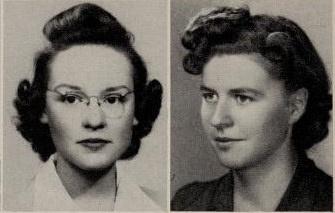

McKinley said, "Losing my roommate the day of Dec. 7, 1941. Hoshie Iwakiri was in K.C. having dinner at a Chinese doctor's home on that fateful day When she got to the bus station to return to Park, she was swept up with other Orientals by the police and incarcerated--held incommunicado. It took the college officials until after midnight to find her!" Ross recounted, "Hoshie Iwakiri, I remember so well: Hoshie, a soft-spoken, shy, but very friendly young woman who observed all things in her world with the eye of an artist. The common knowledge was that her parents--had not wanted her to come to college. In our senior year, the day after Pearl Harbor was bombed, Hoshie came to the library where I was doing my 'Family work ' She was wearing both a hat and gloves and said she was leaving Park She was sad, I was startled out of my wits so was Miss Frances Fishburn Hoshie said goodbye and left. We were stunned! Miss Fishburn notified the Dean's office, and Hoshie was met at the Kansas City bus terminal She agreed to return and stayed until she graduated Thinking back one is aware of how wise Hoshie was to realize that the bombing would negatively affect the lives of her people in this country "
Iwakiri, in 1950, was attending the University of Southern California studying English literature While attending USC, she meet Gerald Alan Soffen and they married in 1956 Soffen was best known as the chief scientist of the Viking mission to Mars in 1976, manager of biological instruments for NASA's Jet Propulsion Laboratory and the NASA earth science program, and director of life sciences (biomedical, space biology, and astrobiology programs) at NASA Iwakiri became a writer, movie critic, and journalist working for the Family Weekly, Suburbia Today, editor for the Shin Hichi Bei Japanese-language newspaper, the Hampton (Va.) Monitor, publisher of a Japanese-American cookbook and press material for the Langley (Va ) Air Force base public affairs office She died in a home pool drowning incident in 1978 She never mentioned the incident on Dec 7, 1941
Park University’s Frances Fishburn Archives and Special Collections has received a 2024 Digital Imaging Grant funded by the Missouri State Library The $30,150 grant will assist in digitizing the George Shepard Park collection that chronicles the narratives of George S Park as an antebellum, Civil War and early Reconstruction civic, political and entrepreneurial leader in eastern Kansas and western Missouri. The scope of the project will be to digitize archival records of George S. Park (1811-90) from pre-birth family genealogical records to 1870. In addition, the grant will assist in digitizing the Industrial Luminary newspaper owned by George S. Park.
The George Shepard Park collection comprises of approximately 246,220 artifacts which includes Civil War, City of Parkville, Mo , genealogical, Kansas territorial, land grants and deeds, military, Missouri Senate, newspapers, church, photographs, publications, Quindaro (Kan.) site, railroad, speeches and listing of additional resources.
This year marks the 180th anniversary of when George S. Park platted the town of Parkville along the Missouri River in Platte County, Mo , less than a decade following the Platte Purchase (1836) The town of Parkville (1844-65) was one of three leading Platte County economic, trading and shipping centers (along with Platte City and Weston) for hemp and tobacco In addition, Parkville and Platte County were major locations connected to antislavery and proslavery conflicts related to the events of “Bleeding Kansas” (1854-61) and the western front of Trans-Mississippi Civil War (1861-65) actions.
George S Park, a businessman, newspaper editor, educator and college founder, was born near Grafton, Vt , on Oct 28, 1811 The son of a farmer, he grew up on the family farm and moved to Ohio where he taught school He traveled down the Ohio River and up the Mississippi River to Illinois, settling in Putnam County He returned to teaching school in Sangamon County, Ill
Following the settlement of the Platte Purchase, which opened land to white settlements in northwest Missouri, George S Park made a claim in Platte County He purchased a steamboat landing site from David and Stephen English where the town of Parkville was platted in 1844 Park worked steadily at acquiring land, encouraging settlement, opening local businesses and expanded riverboat trade He helped organize, in 1845, the Parkville Presbyterian Church which included white and enslaved parishioners Park built a stone hotel next to the river to encourage business.
In 1853 Park started publishing the Industrial Luminary newspaper In the bitter debates over slavery and the tension between Kansas and Missouri over free and slave statehood, he took a position that Kansas residents should be allowed to decide their own affairs without interference from Missouri politics Park’s position incurred the enmity of pro-slavery proponents in Platte County, and on April 14, 1855, his newspaper office was raided, the printing press was thrown in the Missouri River and he was warned to leave Missouri and not to return.
During the troubles of “Bleeding Kansas,” Park took a land claim at Boston, Kansas Territory (now Manhattan, Kan ) with a group of New England settlers interested in starting an institution of higher learning In 1858, he contributed $500 toward this purpose and for the next five years promoted the establishment and operations of Bluemont College (now Kansas State University) Park, in 1866 as a radical Republican, ran for the Missouri legislature He was eventually declared, following the contested election against Daniel Burns, the winner of the Missouri Senate seat.
The Frances Fishburn Archives and Special Collections was awarded in 2022 a similar Missouri State Library Grant to digitize Park University’s Nisei Collection
This project is supported by the Institute of Museum and Library Services under the provisions of the Library Services and Technology Act as administered by the Missouri State Library, a division of the Office of the Secretary of State
Edwin Raymond Barrett (1871-1961) was born in Indianapolis and was reared in the city until 1885 when his widowed mother accepted a position as housemother at Park College (now Park University). Barrett enrolled in the Park College Academy for high school and continued at Park College until completion of his bachelor's degree in 1895
Barrett, following graduation, was a rural schoolteacher at Settle Station, Platte County, Mo , from 1895-96 He departed teaching and was employed at a newspaper in Manitowoc, Wis , and as superintendent of the printing office at Four Corners, N Y Returning to Missouri in 1899, he accepted a teaching position in English at the Presbyterian Academy College, Lawson, Mo Following the closure of the Presbyterian Academy College in 1900, Barrett returned to Park College as a professor of literature
Barrett departed Park College in 1904 to attend graduate school at the University of Kansas where he completed his Master of Arts degree in English From 1905-12, Barrett was professor of English at the First District Normal School (now Truman State University) in Kirksville, Mo Departing in 1912, Barrett moved to Oklahoma A&M College (now Oklahoma State University) as professor of English In 1914, he accepted the position of professor of English at Kansas State Normal (now Emporia State University) where he remained until his retirement in 1944.
Barrett, as a student at Park College, founded the College’s first campus newspaper, The Parkette (now The Stylus) in 1893. His involvement with Park College continued after his departure as the first editor and founder of the alumni magazine, The Park Alumniad, in 1910.
Barrett married Arena Creighton Hodges, Class of 1903, in August 1903. The couple had two sons, Rufus Hodges and Edwin Raymond Jr.
During his undergraduate time at Park, he wrote the following letter to his sister, Mary A. Barrett, Park College Class of 1888, who was serving on missionary duties in Seoul, Korea (now South Korea)
Further information related to the Barrett family and the Barrett Dormitory is available at https://library park edu/ ld php?content id=63230632
Parkville, Mo , Jan 4, 1889
My Dear “Big Sister”
I received your letter yesterday, and this is the first chance I have had to answer it The W M C ’ s are giving a supper this evening in the College Building [1] I am going to have a social this evening all to myself writing letters. I hope to get 3 written and of course you come first.
We all got our presents from you and are highly pleased with them I think that napkins is ‘too utterly toto ’ You could not have suited me better But it makes me a little blue to think that I did not give you and Mother and Lula something after each of you gave me something Mother gave me a Bible, and Lula gave me a box of writing paper of which this sheet is a sample [2] I realize more than ever that ‘it is more blessed to give than receive ’ Mary, I believe if I could live a good Christian life similar to Papa’s and make money simply to give, it would suit me better than anything else I know of Although you are the first human being to whom I have mentioned this, I have thought of it long, long time; and the more I think of it the more I am taken with the idea If have often asked myself ‘should I become a preacher or a missionary?’ Almost invariably the answer comes back ‘ no ’ I have no desire or longing to be such I think if God intended me for such, He would give me an inclination to such work similar to what Prof McAfee describes to us that he had [3] But I was talking about Christmas, to come back to the subject, I spent the day rather drearily I longed for a confidential talk with you but, as that could not be, I took Mayo as a substitute, for I could not get Mother because they had a social at No 2 nearby all day and of course she had to stay there and watch things, and, as you know, there was no talking to her there as the girls have not improved a practical as to coming in her room. [4]
So, Mayo and I wandered about all day except [for] a little while that I was with Sussie Latiner. She asked me to go over in town with her, and, as I thought it to be my last leap year invitation, I accepted. She took me over in town and bought me a dinner worth of candies (that was another present I forgot to mention). Coming back to Christmas, I am glad you got so many presents, but it looks rather suspicious that you got a book from a boarder down there and another from Templeton. Didn’t McClusky send you anything? [5] You should see the lamp he and Benedict gave Mother. [6] She got whole stacks of presents and Lapsley said her lamp was the best present received at the duplex [on] Monday evening. [7]
Last night I heard a phonograph and saw it A man had one on exhibition up to Bergen Hall [8] The thing actually talked, sang, and gave the College yet almost as good as a person could do
I cannot what you advised me concerning Cheever for this reason; according to the new Constitution and Bylaws, one can stay on the inactive roll only one month, and that would not do me any good If I withdraw, I don’t think I shall go to any of the other societies after having been a Cheever [9]
I have sent to you the Monthly’s of the past term
The printers printed another paper this week, the Beacon by name I will send you a copy in this letter if I can get my hands on one
It is 9:30 and your letter not finished. I don’t think I will write anymore, but go to bed when I finish this as I am very sleepy.
Sister, I have been praying for you and I believe my prayers are being answered and I will continue to pray. Pray for me; that I may live more Christ like and nearer to Him in the coming years than I have done in the past; that I may have more zeal and be more successful in my study and work; and that I may, God helping me keep the resolutions I have made.
Prof. McAfee has been in Indianapolis, and now we send about four time as many Records there as we did before. I am learning to play chess and take a great interest in the game. [10]
Clelland is giving us instructions how to sing by the time solfa system I think it is fine
Well, I must close for this time Write to me soon
E R Barrett
P S Your or any napkin ring excites general administration everywhere Mayo says I will have to make a mask to get a girl to take care of it for me
[1] Refers to “Old Number One.” Mackay Hall wasn’t completed until 1893.
[2] Lula was Barrett’s younger sister
[3] Reference is to Dr John McAfee who taught Biblical exegesis, Sabbath school and lay work while serving as president.
[4] Reference to Herman Mayo, Class of 1893, from Auburn, N Y
[5] Reference to Fred W. McClusky, Class of 1889, from Brooklyn, N.Y.
[6] Reference to Fred L Benedict, Class of 1889, from Elmira, N Y
[7] Lapsley McAfee, third son of Dr. John McAfee, was the office secretary in charge of organizing and conducting bookkeeping
[8] A men ’ s dormitory completed in 1888 The dormitory was named for Rev Paul David Bergen (1860-1915) Bergen attended Park College Academy. He conducted missionary work in Chi Nan Fu, Chefoo, Tsingtanm and Tengchow, China He was president of the Shantung Union College / Shantung Protestant University / Shantung Christian University, China, from 1904 until his death in 1915. Further information regarding Bergen Hall is available at https://library park edu/ld php?content id=68248587
[9] A student literary society organized in 1877 named after Dr William A Cheever, a member of the Park College Board of Trustees and pastor of the Second Presbyterian Church in Kansas City, Mo. Between 1885-90, the Park and Cheever Societies created the Literary Monthly containing original student literary efforts and club news Early editions of the Literary Monthly are available at https://library.park.edu/c.php?g=1166820&p=8527598
[10] The Park College Record was a weekly newsletter mailed to thousands of friends, churches and potential donors.

Source: Frances Fishburn Archives and Special Collections
Spencer Cave once commented to student volunteers, “I am glad that my Creator gave me just what he wanted me to do. He had a right to put any color on his clay that he wanted to do. He is the Potter; I am the clay. The first thing that He made was the rainbow with not a speck of black or white Neither black nor white is a color, they are both negatives You draw your color from the rainbow Every man is made from the same chunk of clay ” [1]
Cave was born into slavery on Dec. 4, 1862, to Lewis (a.k.a. Louis) and Aramenta (Johnson) Cave, the second of four children (Arthur, Spencer, Perry and William), on the plantation of Jeremiah Graves near Slater, Mo. The 1860 Federal Census noted that Graves owned three female and five male slaves prior to Cave’s birth.

Source: Jeremiah Graves Plantation, Slater, Mo Source: History of Saline County, Mo
Narratives report that Cave’s paternal descendants escaped to Canada to avoid separation and did not reunite with family members for 36 years [2] Cave’s parents were the property of owners named Craig and Cave who resided in northern Kentucky. Cave’s father, at the age of 13, was sold for $1,200, but records don’t indicate if this sale was to Jeremiah Graves. [3] In 1866, the Cave family left the Graves plantation and traveled onboard the steamboat Emilie toward Westport Landing (now Kansas City, Mo.). [4]

Source: wikipedia org/wiki/Emilie (steamboat)
Lewis, upon arrival in Kansas City, was employed by carpenter and builder John Long located on Ottawa Street (currently 12th Street) between William and Gay [5] Cave’s mother took employment as a cook in Sherman House, located at Grand and 1st Street, consisting of 36 rooms for railroad men [6]
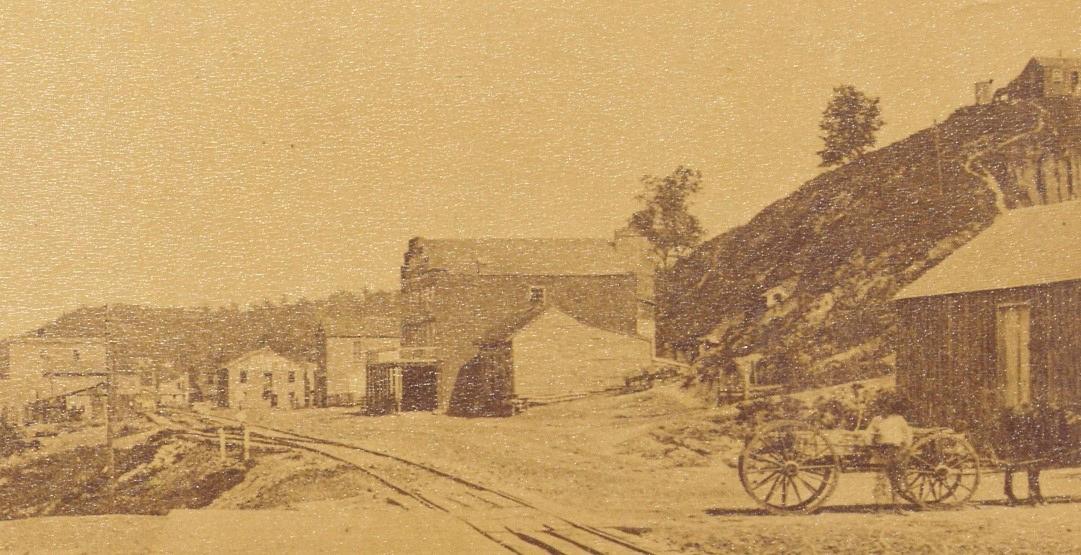
Missouri Valley Special Collections, Kansas City (Mo ) Public Library
In 1867, the Cave family, moved to Kansas City, Kan. A year later, Cave attended the newly opened Colored School of Quindaro (District #17) grade school at Kansas and 8th Street (now (27th Street and Sewell).7 Lewis, according to the 1870 Federal Census, worked as a teamster and the records indicate that he could not read or write
The Cave family again moved in 1870 to Platte County, Mo Lewis began employment on the hemp farm of James Harrison Childs west of Parkville, Mo. Childs was a former colonel in the Confederate army under Gen. Sterling Price, and by 1888, he was one of the largest landowners in Platte County with 550 acres.

Source: 1877 Platte County Plat Book
Cave, at the age of 13, began his more than 70-year [career at Park College (now Park University), except for a one-year leave of absence in 1900 as a porter for the Pullman Company, when Dr John A McAfee, the college’s first president, hired him in 1875 at $1.15 per day. [8] His first task was to cut down a rock hill near the Missouri Valley Hotel (known as Old Number One and later, Woodward No. 1) owned by George S. Park and the original location of the college

Source: Frances Fishburn Archives and Special Collections
The best description of Cave’s influence upon the college community was portrayed by Pauline Hawley, wife of President Frederick Hawley.
“Spencer vigorously scraped the leaves into neat plies for burning Each scrape as if against my heart I pleaded with him to let them be ‘It’s so lovely to hear the scrunch of footsteps in the leaves, Spencer.’ He commented, ‘Funny. You always after me to keep the yards clean, now you asking me to leave all these dead leaves. I try to point out the beauty of the leaf clad slopes.’
Hawley continued, ‘Spencer, who mows the lawn, sweeps the walks, does errands of many kinds, rakes the leaves, spades the flower beds; yard man, philosopher, loyal friend of Park, even sermonizing with the students as they stop to chat with him.’ Cave used to comment that ‘I can tell just what kind of homes these kids are from by the way they come out of chapel.’ [9]
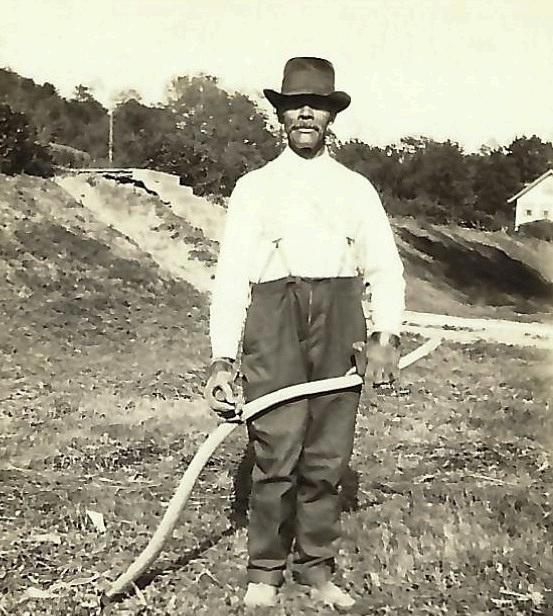
Source: Frances Fishburn Archives and Special Collections
Hawley inquired, “Tell me, Spencer, about the early days of Park College and Parkville ’ He replied, ‘Well, for one thing, way back, you could just step in the woods and get your Thanksgiving turkey. Yes, indeed! There were wild ones in these very woods where I’m clearing and burning under-brush. Besides people raised their own turkeys and chickens and kept cows and hogs. Folks raised their own stuff and didn’t depend on the markets as they do now They had good times too you know people weren’t used to all the doodads of today So if they had a little less they were happy over just a little more When my father, a hemp farmer came to Parkville there were just seven colored families here There was a better chance for him on the Missouri side rather than in Kansas, for although Missouri was bound by chains of slavery, Parkville was a busy shipping point, and the hemp was loaded on boats that docked right down in front and a little bit to the left of the present White House (residence of college presidents on campus). A boat landing always brought a thrill. There was music and dancing, and fashionable ladies used to come to the Halsey Hotel near where the station now stands ’ He continued, ‘Main Street was a crooked lane with rough hewn stones down the middle for travel and thick weeds and underbrush choked the sides If a team met a lady it turned off and let her have the road There were four saloons. And four churches. No women or children ventured out alone after dark for drunken brawls were common. There was lots more religious fervor than now. My! Yes. And everybody went to services. Some might get drunk as a lord but they went to church anyway. Yes’m, the four churches and the four saloons was busy, each trying to put the other out of business ’” [10]

Source: Frances Fishburn Archives and Special Collections
Regarding the college, Cave recalled, “I remember well when Dr and Mrs. McAfee came in 1875. How it was noised about that there was to be a college in Parkville. That the Halsey Hotel was not to be a hotel any longer but that its owner, Park, was giving it to the college. The news wasn’t any too pleasing, the hotel had done a thriving business It had been the center of fashion and many festivities, thus furnishing employment for many colored people Also it housed the C B & Q (Chicago Burlington & Quincy) station and telegraph office. But Dr. and Mrs. McAfee went courageously about their work, starting with their family of seventeen the college that now engirdles the world. A lot of people who didn’t know their A, B, C’s feared Dr McAfee because he was ‘ejucated’ and stood in great awe of him It [referring to the campus] was broken and rough, with uncarved roads Here and there deep rutted wagon trails. Plenty of footpaths the students soon made.” [11]
Blanche Noble Griffith, recollected in 1948, “The first thing he [Cave] did every morning was to go the rounds picking up the stray papers and candy wrappers His route was pass the Chapel, up the Chapel steps to Alumni, around to Copley and Nickel, back along the road in front of Mackay, up the hill to Mackay and around in front of the building, on pass the Library and Science Hall, back around the road in front of Hilltop to Herr House, then behind the Commons (now known as Thompson Commons) and down the hill, generally to the President’s garage where he kept his tools After this tour of inspection, his day’s work began ” [12]

Source: Frances Fishburn Archives and Special Collections
Cave was known as a casual philosopher, one who had known life and pursued it to its deeper spiritual meaning. Intensely religious, he declared the Bible to be a thorough education in itself He read books and papers to be informed on current affairs, but declared the Bible had always been the basis of his study In spite of the hardships a humble origin and the prejudice with which his race was confronted, he faced life eagerly, believing in that wellknown, little-remembered verse, “Ask and ye shall receive.” He was a little curious as to how such a prejudice is reconciled to the doctrine of Christianity, but he laminated, “I shall, day by day, live so that I shall bring honor to my race I shall talk freely with students in an attempt to understand them, and with the hope that they in turn will understand me, and through friendship with students I shall help to break down the barriers and prejudices of many generations.” [13]
The wise words of a beloved sage Spencer Cave passed on June 21, 1947
View some 16mm film from the archives on Spencer Cave at https://youtu.be/1UAn9C3rm6Q or by scanning the QR Code

[1] Spencer Cave, “Student Volunteers,” Nov. 9, 1941. Frances Fishburn Archives and Special Collections, Park University, Parkville, Mo
[2] Juanita Schoff, “Spencer Cave, Student of Life,” Jan 22, 1947 Fishburn Archives [3] Ibid
[4] Owned by Joseph LaBarge and built in 1859 The steamboat was 225 feet in length https://en wikipedia org/ wiki/Emilie (steamboat)
[5] “Carpenters and Builders,” The Kansas City Directory and Reference Book with a Business Directory for 1867-8 (Quincy, Ill , Excelsior Book and Job Office, 1868), 189
[6] The Kansas City Directory and Reference Book with a Business Directory for 1867-8, 18 [7] https://quindaro kckschools org/about/school-history and https://kansascollection omeka net/items/ show/278 On April 12, 1858, “The Common Council’s Committee on Finance” that a school for Caucasian children had been erected at a cost of $2,000 ($73,991 in 2024) and a teacher hired at $700 ($25,897 in 2024), while the school for African American children had been built at a cost of $500 ($18,498 in 2024) and a teacher employed at $300 ($11,099 in 2024). Patricia Adams, “Site Number 72: First Colored School of Quindaro/Vernon School,” Loren L. Taylor, A Historical Overview of Wyandotte County and Its Historic Sites (Kansas City, Kan., Wyandotte Historical Society, 2009), 287.
[8] In 1875, the weekly salary would have been $5.75 and an annual salary of $299. In 2024, the daily wage would be $31.72, weekly salary would equal $158.60, and an annual salary of $8,247.20 based on five-day work week.
[9] “As the Leaves Fall” Park College Record, February 1935, 1-4. Fishburn Archives.
[10] Ibid
[11] Ibid
[12] Blanche Noble Griffith, “Spencer Cave” Oct 13, 1948 Fishburn Archives Griffith (1890-1954) was the wife of Dr Charles Leonard Griffith, faculty member
[13] Ibid.
Dr. Neil Humad Baxter, Professor of History
Baxter was born in Waterford, Pa , Aug 11, 1895 While attending Drake University in Des Moines, Iowa, following his freshman year, he was called to military service in World War I His registration card reflected that he was medium height, slender, and with brown hair and eyes During the war, he contracted influenza, from which he never fully recovered
Returning from the war, he enrolled at Butler University in Indianapolis and earned a bachelor’s degree in history in 1922 Following his undergraduate studies, he taught English and the Bible at Calegio Internacional in Asuncion, Paraguay, between 1923-25
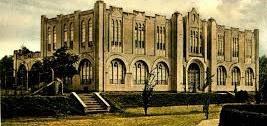

Baxter returned to the U S in 1925 and enrolled at the University of Chicago where he earned a master’s degree in history in 1927 He arrived at Park College (now Park University) in the fall of 1927 as an associate professor of history and was promoted to full professor in 1936 after earning a doctoral degree in history from the University of Iowa
During the summer of 1933, he taught at the Asheville (N C ) Normal and Teachers College where Park College alumnus Dr John Edward Calfee, 1905, was president The institution was established in 1887 to train young women as teachers for rural schools, eventually to include a home school for girls and a farm school for boys
In early November 1936, Baxter became ill due to heart troubles and related complications He died on Dec 3, 1936 An editorial in The Stylus (Park’s student newspaper) commented upon his death, “He was a friend of every student enrolled here His keen, superior mind surmounted the bounds of the average His views were not encumbered by the petty problems that vex many of us ”
Baxter was active in a number of campus activities, including the YMCA and as club sponsor for the International Relations Club and the Committee on the Library
Photo credit: facebook com/pydeantes/posts/colegio-internacional-ca-1930-el-colegio-internacionalcomenz%C3%B3-como-un-internado/280727370041115
Rev. Frank William and Henrietta (Caskey) Bible
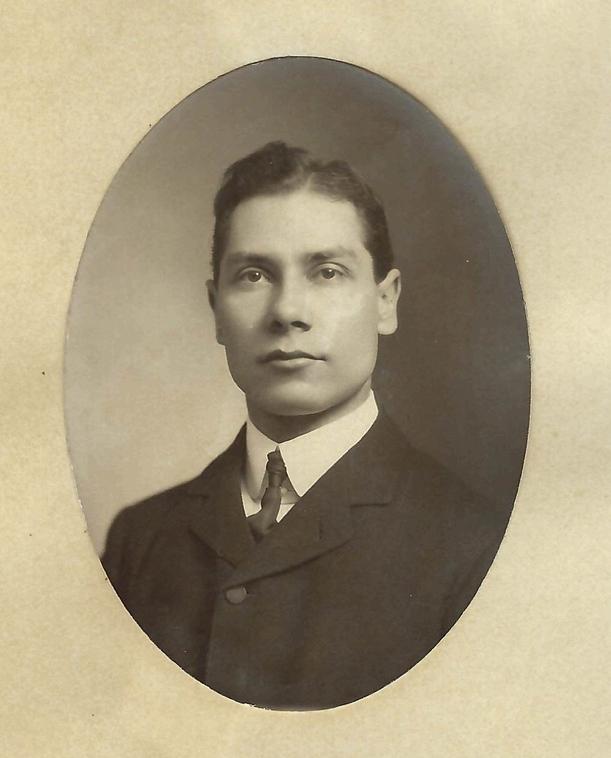

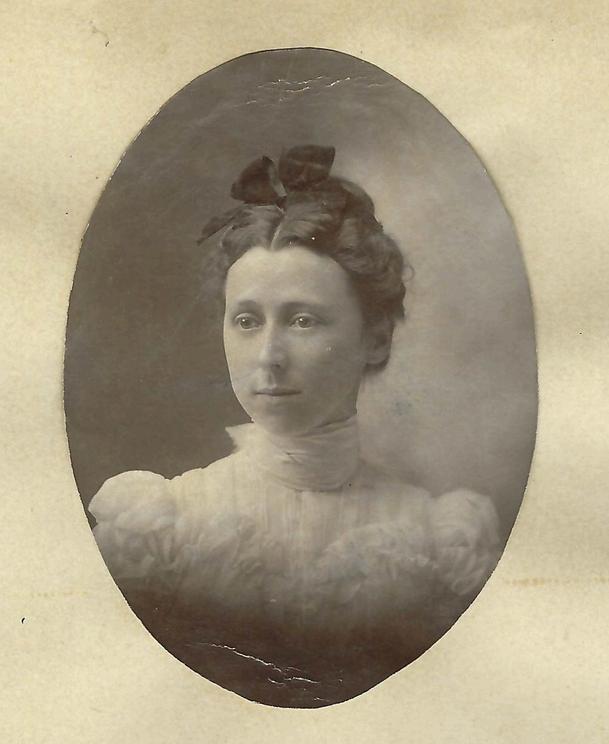
Frank was born in Milesburg, Pa., on July 18, 1877, the son of Frank Edminston and Mary Alice (Minsker) Bible. His early schooling was at Bellefonte and Tionesta, Pa. He entered Park Academy in 1896 and graduated from Park College in 1901. Following graduation, he entered Auburn Seminary, graduating in 1904. Henrietta Caskey was born in St. Paul, Minn., on Aug. 25, 1874, the daughter of Alexander Lynn and Frances (Van Doren) Caskey. Her father served in the U S Army and in the Union army during the Civil War She graduated from Park College in 1900
The Bibles application to the Presbyterian Board of Foreign Mission noted testimonials for Henrietta from Rev Cleland B McAfee “She has a strong and pleasant personality, is refined, cheerful, energetic and well able to work with others ” Professor Arthur L Wolfe said, “I expect that she and Mr Bible will form an exceptionally strong pair of missionary workers ”
The Bibles were commissioned by the Presbyterian Board as missionaries to China from 1904-19, with headquarters in Hangchow During his tenure in China, Frank was an Associated Press correspondent in Chehkiang reporting on the overthrow of the Manchu dynasty, president of the Hangchow Christian College, chairman of the board of the Union Girls’ School in Hangchow, member of the board of directors of the Union Seminary at Nanking and served on the China Council of the Presbyterian Missions. He traveled extensively throughout China as a student of internal affairs. His travels extended to Manchuria, Korea and Japan.
The Park College Record of March 1908 wrote, “Rev. Frank W. Bible returned from China last fall after four years of work. The occasion of his homecoming was the illness of his wife. Mr. Bible opened his campaign in Omaha, Nebraska, last Sunday in the interests of missions in China.” Records omit Henrietta’s specific health issue requiring her return, but during her application for missions, there are several notes of tuberculosis in the family history and a physician note “concerning her tendency to phthisis.”
The Bibles returned to the U S in 1919 due to Frank’s ill health where he was appointed associate general secretary of the Committee of Reference and counsel of the Foreign Missions Conference of North America where he remained until 1924 That year, Frank was named by the Presbyterian Board as secretary in the Central District, with headquarters in Chicago
Testimonials to his work noted, “I believe he is one of the best Men’s speakers that I have ever heard If we could put Mr Bible into every church to address the men, our Missionary program would be carried out ” And, “I consider him in every way worthy of a place in the great succession of foreign mission prophets ” In 1929, Frank was elected as executive secretary in the Home Base Department which directed field activities in the western U S
In 1920, Frank entered upon a tour of foreign mission stations in Syria, Persia, Egypt, Palestine, India, Siam, the Philippines, China, Chosen and Japan where he studied and reported on conditions throughout the Presbyterian foreign mission areas.
Frank was the recipient of two doctorate degrees and was twice president of the Park College Alumni Association in 1926 and 1937.
Frank and Henrietta were married on May 25, 1904. The couple had six children: Frank W., Class of 1929, Alice, Ruth, Mary, Beatrice and Barbara Daughters Ruth and Mary both died five days apart in 1911 Frank died on Nov 15, 1937 Henrietta died on April 3, 1952 The couple are buried in Union Cemetery, Bellefonte, Pa

https://chinachristiandaily.com/news/ photo/2022-05-18/hangchow-christian-college-inzhejiang-province-11474
Former president of the Society of American Archivists Randall C. Jimerson commented in his paper “Embracing the Power of Archives” (2005) that archives are “ a place of knowledge, memory, nourishment and power. Archives protect and preserve records; legitimize and sanctify certain documents Records represent evidence, information, truth and social memory Archives provide [a] record of an agreement made at a certain time, by one or more persons, about individual actions, events and stories ”
Over time, individuals, organizations and governments create and maintain information about their activities Archives maintain those records, such as correspondence, diaries, financial and legal documents, photographs, video and sound recordings, and electronic records, that have enduring value as collective memories of the past and assist individuals to understand the collective information Records maintained by archives protect the rights, property and identity of individuals, organizations and governments, and ensure that those records are accessible for current and future dissemination
Three previous individuals Frances Fishburn, Class of 1921, Dr Harold Smith, Class of 1944, and Carolyn Elwess, Class of 1971 devoted decades to the more than a century of collections associated with Park College (1875-2000) and Park University (2001-present). Park stories endure to be fulfilled and treasured. However, Park’s history necessitates further collection acquisitions, professional measures of conservation, digitization, and preservation, public programming and social media, student internships and specialized resources.
The commemoration of Park University’s sesquicentennial furnishes opportunities to reflect on our former, present and future distinctiveness, and appreciation of our fides et labor (faith and labor) as a continuing pioneering institution of higher learning.
Collection Acquisitions: The “Recent Acquisitions” story on page five highlights the continued donations and purchases which expands new, or extends, current collections. If former students, alumni or their descendants have materials or artifacts related to Park College or Park University and/or their military service (such as the Spanish-American War, World War I, World War II, Korean War, Vietnam War, Desert Shield/Desert Storm, Global War on Terror), the University’s Fishburn Archives and Special Collections staff would be honored to be the official depository More information is available by contacting the Archives at archives@park edu Professional Measures of Conservation, Digitization and Preservation: The “Digital Imaging Grant” story on page 36 highlights continued efforts to digitize collections Since 2022, the Fishburn Archives has received more than $75,000 in grants to conserve, digitize and preserve the Nisei and President William L Young collections containing more than 2,100 artifacts, and the recent grant will conserve, digitize and preserve more than 246,000 artifacts related to George S Park before 1870 Additionally, recent initiatives digitized a 16mm film featured in the related “Fun Facts,” “V-12 Program” and “The Caretaker of Park: Spencer Cave” articles
Public Programming and Social Media: The Frances Fishburn Archives and Special Collections Facebook page highlights weekly posts of “WorkinWednesday,” “FotoFriday,” “StructuralSunday” and special postings. In October, staff will launch virtual presentations called “Pirate Chats” to highlight more in-depth stories related to Park’s history. Additional initiatives under consideration for the sesquicentennial include missionary and veteran databases, transcriptions of former student and alumni diaries, publication of building histories, rotation of short-term and installation of additional permanent exhibits on campus.
Student Internships: Provide students internships and assistance to staff in projects.
Specialized Resources: Acquisition of specialized archival supplies and technology to assist in conservation, digitization, preservation and storage. These resources furnish means to continue implementation of professional archival and collection management standards.
National Archives Month provides an opportunity to engage with past narratives, but continue Park’s legacy for future decades and generations
Park College (now Park University), between 1880 and the late 1940s, educated approximately 450 young men and women that served the home (e.g., U.S.) and foreign missionary fields.
These alumni, in appreciation of their education and connection to Park, gifted religious works representative of the cultural diversity they engaged Park has 194 of these religious works, and to commemorate National Bible Month, the staff in the University’s Frances Fishburn Archives and Special Collections highlights one work, the Siamese Bible – Presented to Park College by the Alumni of Park in Siam – 1916 Siam, in 1939, changed its name to Thailand

9.625 x 5.75 x 3.5
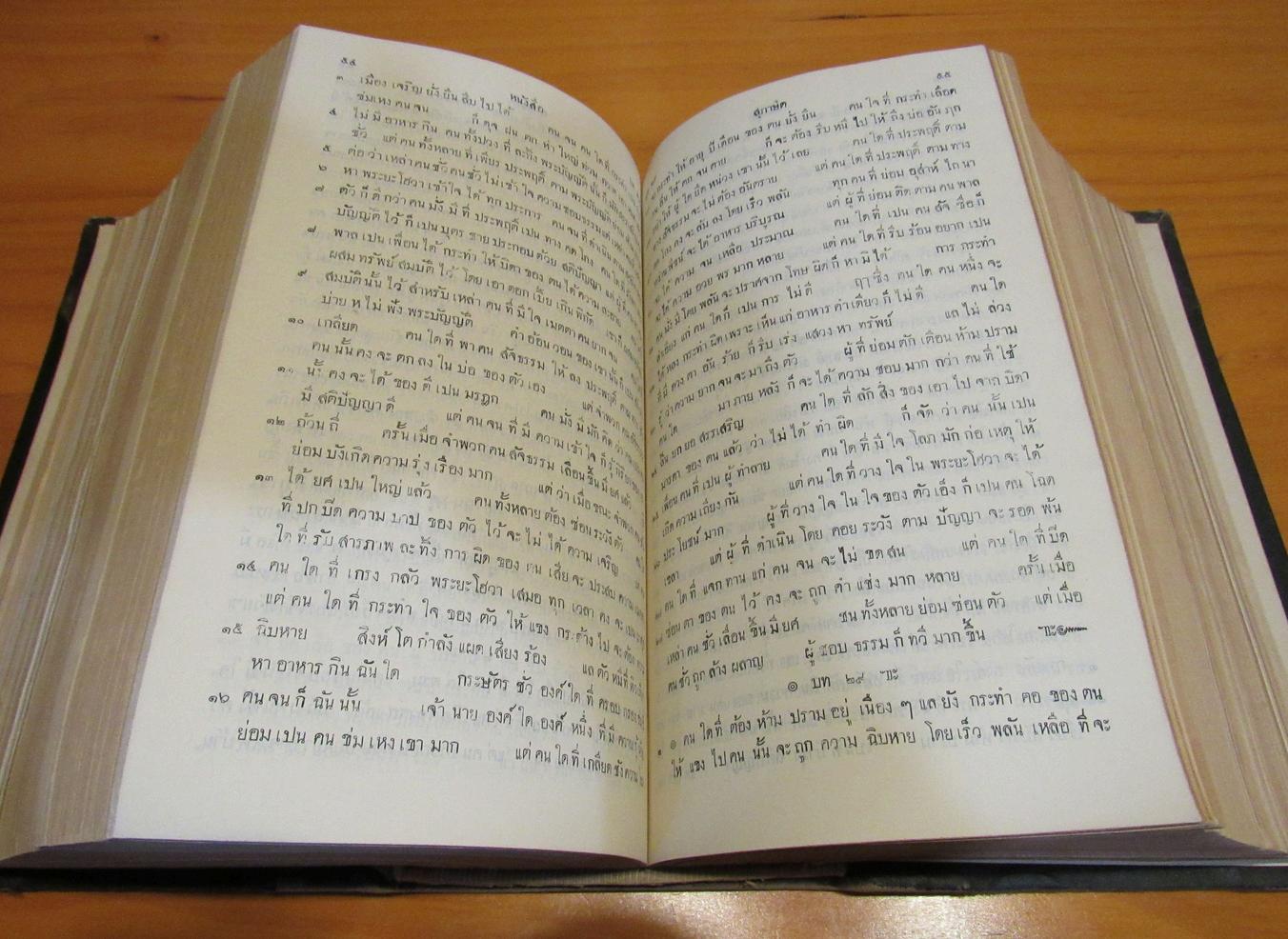
The printing of the Bible was conducted under the care of Rev. Robert Irwin, Class of 1887. Irwin was the agent of the American Bible Society in Siam from 1911-32 and served on the Revision Committee of the South Siam Mission which undertook translations of the Bible into the Siamese language Irwin published “Siam and Laos Agency Prayer Calendar” in 1926, “Jesus Big Ideas” in 1940 and “The Gospel of Mark in Verse” in 1941

Rev. Robert and Dr. Mary (Bowman) Irwin
Source: Payap University Archives, Record Group 011/78a.
The leather incorporated into the binding was tanned at the American Presbyterian Mission Tannery located in Lakawn Lampang, Siam, under the superintendence of Dr Charles Henry Crooks, Class of 1901 Crooks entered Park Academy 1893 and matriculated to Park College in 1897 While attending the Academy and College, he was employed in clearing land, grading campus, carpentry, stone force, and during his senior year, was in charge of the boy’s dormitory
Crooks commented on an undated alumni survey, “The training in carpenter work at Park was of especial (sic) value on the foreign mission field When [I] first reached the field, the [Siam] Mission was still young, and a building program was active in all the Stations ”
Florence (Bingham) Crooks, Class of 1900, wrote in 1958, “Dr Crooks built up the Charles T van Santvoord Hospital in Lampang, Thailand the first self-supporting hospital in the Thailand Mission He was consistent always in his opinion that the Thai should have an institution as soon as they were able to take over In all, Doctor Crooks worked in four different stations but twenty-five years in his major project in Lampang.”
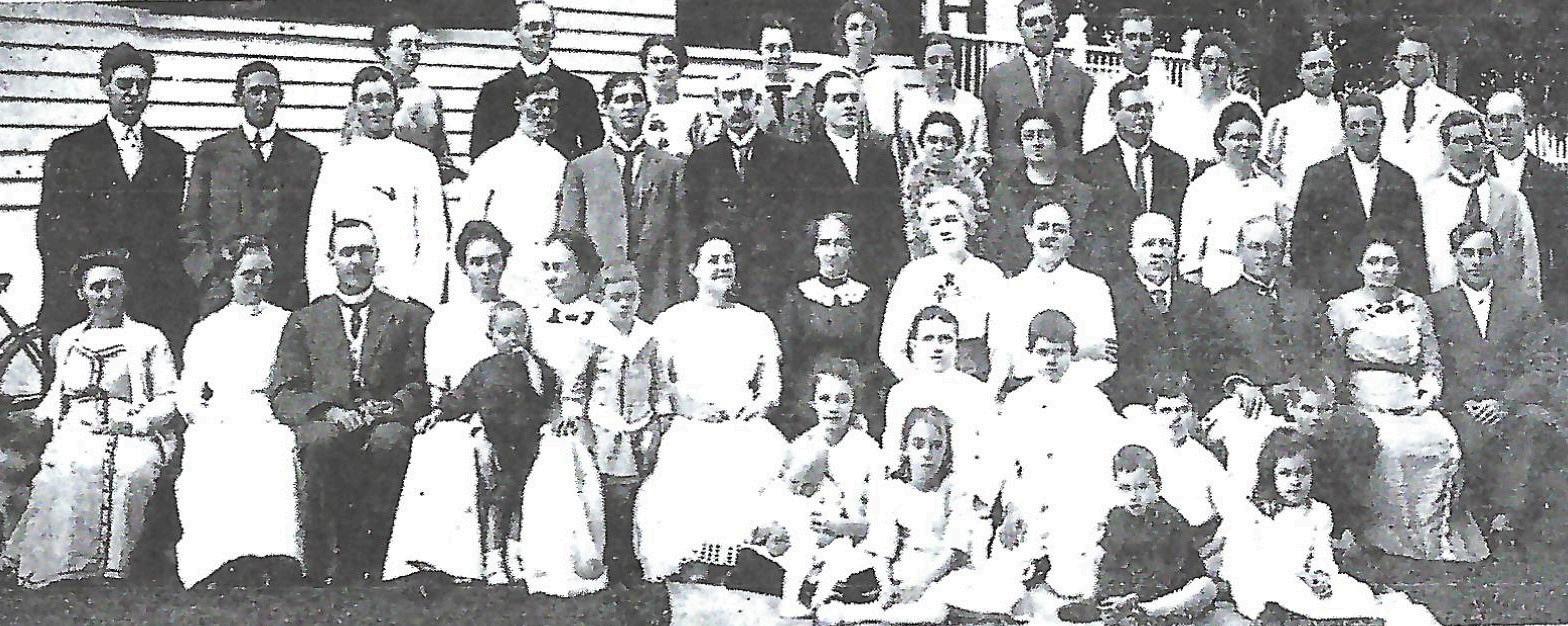
The North Siam Mission staff Irwin is the second to last individual in the second row, far right The Crooks are in second row, center
Source: “Heard Behind the Curtain,” Woman’s Work: A Foreign Missions Magazine (May 1915), 106
The tannery was a component of the industrial department of the Kenneth Mackenzie Memorial Boys’ School directed by principal Arthur B McMullin, Class of 1912 The school was established by the Presbyterian church in 1890 and named Mackenzie in 1910, for a young boy who had died.
The Siamese Bible was printed and bound at the American Presbyterian Mission Press, Bangkok, Siam, managed by Edward M. Spiman, Class of 1909.
The price of the Bible in 1916 Siamese currency was Ticals 6.25, the equivalent in gold being $2.35 (2024, $68). If the Bible were sold at actual printing and binding cost, in 1915, it would have been about $4.75 (2024, $137).
The June 1909 listing of horses and mules. The monetary value of both horses and mules in 1909 equaled $4,135 which is equivalent to $142,712 in 2024.
Horses:
Barney ($90)
Beauty ($125)
Bess ($75)
Bet ($100)
Clara ($20)
Dick ($20)
Edith ($100)
Fly ($20)
Fred ($115)
Harrison ($40)
Kate ($125)
Mag ($125)
Navy ($75)
Ned ($90)
Pet ($125)
Phillip ($50)
Tom ($75 with fistula)
Valasco ($50 with fistula)
Mules:
Alice ($75)
Beck, Jr ($185)
Beck, Sr ($75)
Billis ($112 50)
Bud ($200)
Del ($150)
Dempsey ($65)
Dora ($110)
Frank ($112 50)
Fred ($140)
George ($125)
Jack ($130)
Jake ($125)
Joe ($130)
Kate ($75)
Louden ($75)
Nig ($140)
Nip ($60)
Pete ($130)
Sid ($140)
Tobe ($135)
Tom ($200)
Tuck ($25)
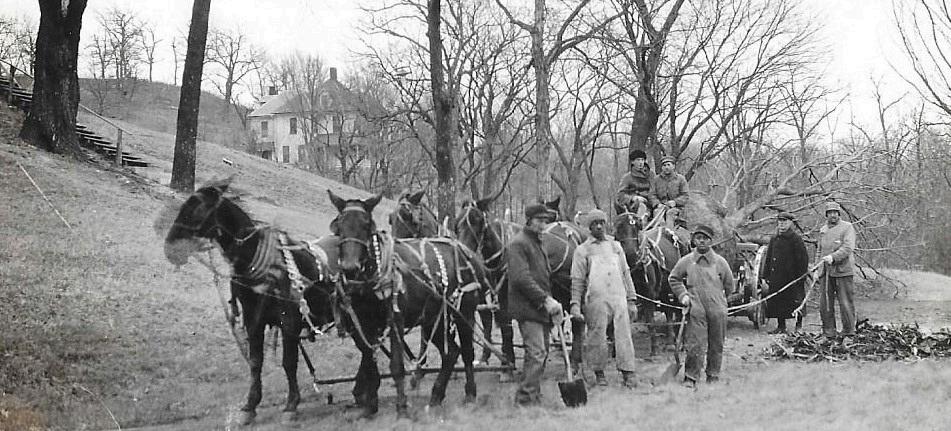

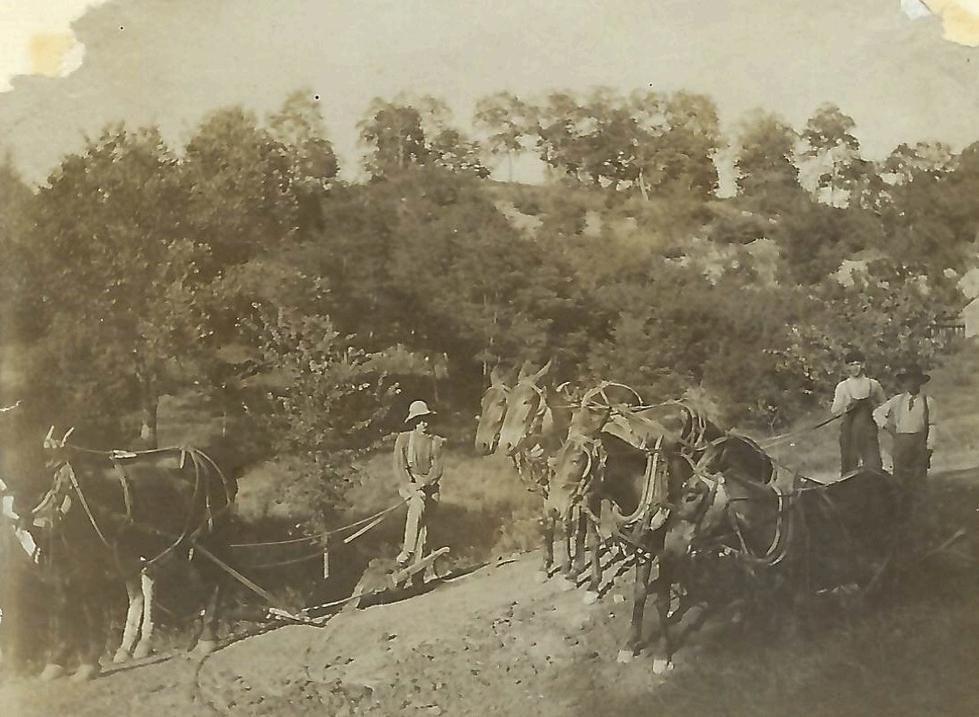
View some 16mm film from the archives on the laundry horse delivery laundry at https://youtu.be/2agGp3eaLH0 or by scanning the QR Code

In January 1925, the Park College (now Park University) student body was rewriting its constitution. Amid the various submissions was a proposal to design stickers that would be symbolic of other regional higher education institutions An initial student committee composed of Louis Weber, Class of 1925, and Chester Moore, was selected to choose a name or mascot which would be voted on by the student body However, within a month, a second committee composing of Murray Kinkel, Gladys Wakefield, Class of 1926, Robert Gibson, Class of 1925, Ralph McCrary, Class of 1925, and Newell Smith, Class of 1928, was formed which dedicated time and effort to creating an identity Numerous names were submitted, such as “Hill-billies,” “Eagles,” “Cardinals,” “White Mules” and “Goats,” according to The Stylus on Feb 26, 1925
On April 23, 1925, The Stylus included an article on the new constitution presented to the student body for ratification, including Article I that stated, “The official name of the Park College students shall be Pirates ” Just weeks before Park’s golden anniversary, the new constitution and mascot was approved by the students on May 1, 1925, with the Pirates name victorious over Eagles and Panthers There remains, even after a century and several theories, no definitive explanation for the selection However, two nautical phrases have more recent application: the “Jolly Roger,” as the former Galley in Thompson Commons (student center) and currently in Norrington Hall, and “The Pirates Den” as the former bowling alley in Labor Hall (now known as the Intramural and Recreational Fieldhouse).


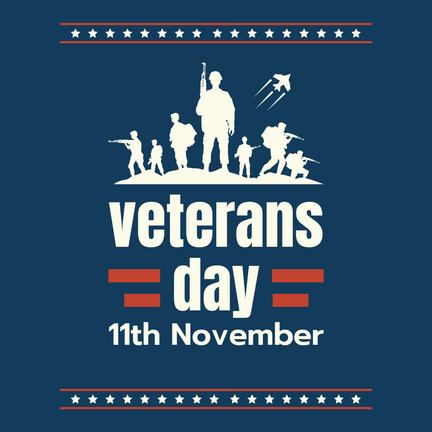
Veterans Day commemorates America’s veterans for their patriotism, devotion to country and readiness to serve Originally called Armistice Day, President Woodrow Wilson proclaimed on Nov 11, 1919, “To us in America, the reflections of Armistice Day will be filled with solemn pride in the heroism of those who died in the country’s service and with gratitude for the victory, both because of the thing from which it has freed us and because of the opportunity it has given America to show her sympathy with peace and justice in the councils of the nations ” In June 1954, President Dwight D Eisenhower signed legislation changing the holiday’s name to Veterans Day
Park University has an extensive history of students and alumni who served and are currently serving our nation The University’s record of that history, however, was infrequently recorded or not chronicled in obtainable sources over the past century. Over the past two years, Ashlyn Weber, a former associate director in Park’s George S. Robb Centre for the Study of the Great War, commenced compiling the foremost listing of Park’s veterans. Staff in the University’s Frances Fishburn Archives and Special Collections continue research efforts related to World War II, the Korean War and the Vietnam War. As the nation and University commemorates Veterans Day on Nov. 11, below is completed research from the Civil War through World War I.
If former Park University students, alumni or their descendants have artifacts related to military service from the Spanish-American War, World War I, World War II, Korean War and/or Vietnam War, the Fishburn Archives would be honored to be the official depository for those artifacts. Please contact Tim Westcott, Ph.D., associate university archivist, at archives@park edu to discuss

Barkhurst, Bert
Buchanan, Sanford
Bybee, David
Carson, Wilbur
Derr, Homer
Eskridge, James
Hart, R
Lamme, Robert
Law, Archie
McGeehan, Paul
McMullin, Arthur
Merchant, Grant
Newton, Harry
Pipkin, Charles
Sloan, Horace
Steele, Horace
Wilson, John Woodard, Harlan

World War I (1917-18) -- 235 veterans
(+ Killed In Action)
Acosta, Primitivo
Acosta, Emilio
Akin, Elbert
Alexander, Erastus
Allen, Paul
Altfather, Ellis
Anderson, Samuel
Appleby, John
Arnold, Mason
Bardsley, William Barnes Edward
Bechtold, Edmund
Berry, Chauncey
Bixler, William
Bixler, Joseph
Blair, Paul
Blevins, Beeler
Blodgett, Warren
Bohannon, William
Boney, Bruce
Bousman, Henry
Boutwell, Lloyd + Bradford, John
Brayton, George
Bredberg, Martin
Brink, James
Brink, Charles
Brown, Royal
Brown, Frederick
Brown, Covert
Brown, Hubert
Browning, William
Cargill, Myrtis + Chambers, Ralph
Charr, Easurk
Christoff, Henry
Clark, Howard
Clarke, Laurel
Congdon, James Cook, Seldon
Cooksey, Warren
Cornelius, Harry
Course, Elwood
Cramer, Buell
Crangle, William
Cribbs, Harold
Cuthbertson, Duncan
Daniel, Glover
Davis, Raymond
Dawson, Frederick
Dean, Arthur
DeArmond, Clinton
DesJardien, Alphonse
Dessieux, Paul
Dodge, Fields
Dry, Paul
Elward, Martin
Emerson, Emmons
Evans, Thomas
Filson, Floyd
Fisher, Edgar +
Flamson, George
Foster, Hugh
Frizelle, Frederick
Galbraith, Lewis
Galbraith, William
Gallardo, Jose
Geissler, Paul
Gleason, Jay
Glunt, Glenn
Goodrich, Louis
Graham, James
Grattan, George
Hamilton, James +
Hamilton, Clarence
Hammer, Irwin
Hanson, Victor
Hare, Frank
Harris, Charles
Harrison, John
Hathaway, Carson
Helwig, Frederic
Hemphill, Olivia
Hillman, Clinton
Hoffman, George
Huckabee, Thomas
Hudson, James
Hughes, Lewis
Hurley, Curtis
Hurley, Lawrence
Ice, Lloyd
Idol, Eugene Irwin, Donald
Jacobs, Elijah
James, Raymond
Jamison, Jesse
Jones, Lewis
Kallemeyn, Henry
Kent, Joshua
Kent, Leonard
King, Alva King, Samuel Knotter, James Ladd, Robert
Laine, Maurice
Lamb, John
Langfitt, Harry
Leck, Laurie + Leke, William
Lentz, Theodore Leonard, Frederick
Lewis, Alexander
Lindstrom, Charles
Listrom, Joy
Locher, Edward
Luthy, Frank
Lyle, Everett
Macelree, James
Mackey, Elmer
MacQuiddy, Ernest
Magers, Malcolm
Manchester, Paul
Martin, Garner
Mayes, Bailey
Mazzei, Peter
McAfee, John
McAfee, Lapsley
McAllister, Bearl
McCall, Henry McCall, Thomas
McCandliss, William McClure, William McClusky, Frederick
McCorkle, Walter
McElhinney, Ralph
McFarland, James McGarvey, William
McGeehan, Paul
Meyer, John
Miller, Franklin
Montgomery, Atwell
Montgomery, Melville
Mordy, Thomas
Morgan, Barney
Moritz, Jesse
Morrison, Paul
Murray, Lynn +
Myers, John
Newhouse, William
Noland, Leonard
Officer, Forrest
Oliver, Malcom
Orr, Cameron
Orr, Charles
Orr, John
Parker, Alvin
Parker, John
Parker, Malcom
Parks, William
Parsons, Homer
Paxton, Edwin
Peck, Wyatt
Peeke, James
Peeke, Raymond
Penniston, Jennings
Penniston, John
Philpin, John Pierce, Walter Piper, Merle
Porter, Dwight Powell, George Prentice, George
Preston, Joseph
Priest, Vincil
Primm, Clarence
Pruitt, Lawrence
Purviance, Walter
Raceley, Robert
Riester, George
Rinderly, Carl + Robb George (MOH)
Ruhl, Hesser
Schenck, Ellsworth
Schermerhorn, Clelland
Schmalhorst, Hoeting
Schwegler, Bartley
Seamans, Harry
Selsor, Fred
Shaw, Irwin + Shetler, Stanley
Shimmon, George
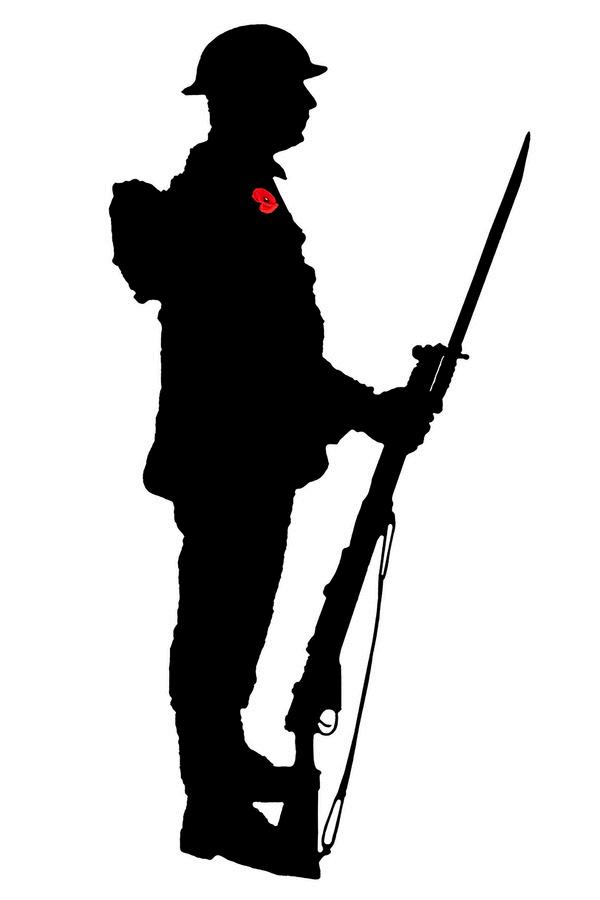

Shouse, Everett
Simpson, Dana
Smith, Herrick
Smith, Reginald
Smith, Robert
Stephenson, William
Stevenson, Dwight
Stevenson, Ross
Stoops, Richard
Stotts, Robert
Strickel, Charles
Swanson, Roy
Taul, Alexander
Thomas, Albert +
Thompson, Thomas
Torgerson, Clarence
Torrence, James
Towne, Ralph
Trett, Edward
Tuggle, Garland
Tuggle, Jesse
Van Dyke, Dewey
Votaw, Howard +
Wachter, Willard
Wallace, Andrew
Waters, Walter
Weber, Paul
Weer, Mark
Weldon, Lloyd
Westfall, Fessenden
White, William
White, Charles
Whitney, Frederick
Wickerham, David
Wightman, Howard
Wilcoxson, Chester
Williams, William
Wilson, Burney
Wolfe, Arthur
Wolfe, Austin
Wolfe, Herbert
Woodward, Charles
Wylie, Lloyd
Zutrau, Morris

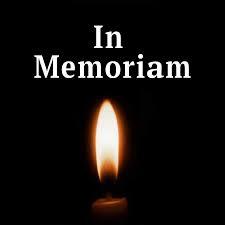
Arnold, Larry Atlee, 1975 (Criminal Justice Administration)
Aronson, Arthur Scott (No Degree)
Asano, Michiko Hosomi (No Degree)
Baron, Pamela Ann, 2000 (Management/Human Resources)
Beall, Howard Lee, 1967 (Education) [U.S. Air Force]
Bennett, Barry, 2008 (Public Administration)
Bialecki, John Francis, 1981 (Management/Human Resources) [U.S. Marine Corps and U.S. Air Force]
Bilger, Dara, 2009 (Social Psychology)
Billeter, Thomas, 1987 (Management) [U S Air Force]
Bledsoe, Ricky (“Rick”) James, 1999 (Accounting) [U S Marine Corps]
Bogren, Shirley Ann, 1955, (Recreation)
Bohi, Ariane Nichelle, 2007 (Business Administration/Marketing)
Brackett, Stephanie G , 1967 (Education)
Brooks, Katie Frances (Rodina), 2007 (English)
Brown, Doris Earlene, 1980 (Social Work)
Bucher, Bruce Myron, 1959 (Natural Science)
Cizmar, Jeannette Christina, 1994 (Nursing)
Cobb, Phyllis Ray, 1958 (Chemistry)
Cook, Ida Marie, 1978 (No Degree Information)
Cousineau, Betty Lou, 1988 (Social Work)
Darby, Gloria Nell, 1988 (Nursing)
Dent, George Steven, 1986 (Management/Human Resources) [U.S. Air Force]
Doughty, Jacqueline Marie, 1985 (Management)
Edwards, John (“Jay”) Nelson, Unknown Year, (Sociology)
Emerson, Drew David, 2014 (Criminal Justice Administration)
Fackler, Paul K. "Kelly", 1991 (Management) [U.S. Air Force]
Fernandez, Ramon, 2002 (Criminal Justice Administration) [U.S. Army]
Fontaine, Melba Mussette, 1993 (Computer Science)
Freed, Mark Alan, 1994 (Computer Science) [U.S. Marine Corps]
Frizzle, Janet Ruth (Bard) (No Degree)
Gaggens, Sara Lou, 1959 (Education)
Garza, Rafael, 1981 (Social Psychology) [U S Army]
Gittman, Carole Anne, 1985 (Criminal Justice Administration) [U S Army-WAC]
Green, Nancy, 1971 (Unknown Degree)
Gregory, Jewell Louann Kirchner (No Degree)
Griggs, Earlene Agnes, 1995 (Management/Human Resources)
Gustafson, Charles Ronald, 1974 (Economics) [U S Air Force]

Harris, E Warren (No Degree) [U S Navy]
Hedenkamp, George Joseph (Salvato), 1973 (History) [U S Air Force]
Heegn, Catherine Eunice, 1994 (Finance and Management Information Systems)
Helms, George, 1984 (Management) [U S Air Force]
Henderson, Betty Bryan, 1950 (Art) [U S Marine Corps]
Hirsch, Barbara, 1972 (Art)
Hurula, H William, 1982 (Business) [U S Army]
Ingraham, Judith Anne, 1981 (Social Psychology)
Jackson Jr., Lawrence, 1976 (Psychology)
Jansen, Linda Kay (No Degree)
Jewell, William Kent (No Degree)
Jones, Verlin Leroy, 1989 (Management/Human Resources and Management Information Systems) [U.S. Army]
Kane, Norma, 1982 (Management/Human Resources)
Kasper, Travis W., 1993 (Social Psychology) [U.S. Air National Guard]
Keaton, Galen Spencer (No Degree) [U.S. Army]
Kinate, Christopher Mathew, 1984, (Management)
King, Steven, 1994 (Management)
Kirby, Jr , Quitman Lorimer, 1974 (Political Science) [U S Army]
Klein, Bruce Alan, x1970
Koppers, Daniel “Danny”, 2007 (Psychology)
Kott, William, 1967 (Biology)
Lankford, Erin Ann, 2005 (Education)
Larrick, Dean, 1953 (Political Science) [U S Army]
Larson, Lawrence, 2015 (Management Information Systems) and 2018 (Business Administration) [U S Army]
Lasaster, Glenn, 1981 (Management) [U S Army]
Ligman, Todd A , 1996 (Healthcare Administration) [U S Air Force]
Love, Bert Gregg, 1982 (Management) [U S Air Force]
Martin, William, 1978 (Management) [U.S. Navy and U.S. Air Force]
McKeon, Bruce H., 1971 (History)
Meinke, Jon Paul, 2001 (Economics)
Munson, Julia Speer, 1964 (Biology)
Nastasi, Mary Jo (Davis), 1996 (Social Psychology)
O’Loughlin, Earl T., 1973 (GEST) [U.S. Air Force]
Owens, Jr., Samuel D., 1983 (Management) [U.S. Air Force]
Paradeza, Patricia, 1991 (Social Psychology)
Payne, Janis Kay, 1997 (Social Psychology)

Peacock, Paula Lorayne Anderson, 1990 (Business)
Pradhan, Ode to Utsav, 2011 (Masters in Business Administration)
Proctor, Mary Leigh, 1996 (Computer Science) [U S Air Force]
Reed, Diane Davis, 1965
Reynolds, Lisa, 2011 (Management/Computer Information Systems)
Richardson, Nona, (1958) (Education)
Robbins, George S , 1973 (Business and Economics) [U S Air Force]
Robinson, Hinston Marvin, 1973 (Psychology) [U.S. Army]
Routh, David, 1994 (Master’s in Public Administration)
Rumph, Robert, 1990 (Management)
Sampson, Jacquelynn Eleace, 2004 (Management/Accounting)
Saunders, David "Satch", 1975 (Literature)
Scholta, Mary Ann, 1972 (Elementary Education)
Scott, Bruce Billings, 1963 (Psychology)
Sexton, William, 1985 (Social Psychology) [U.S. Air Force]
Shildt, Constance, 1980 (Management)
Simpson, Barry D , 1959 (Speech)
Snyder, Jon Alan, 2015 (Management Information Systems) [U S Navy]
Spradling, Mary Lou, 1947 (Associate Degree)
Staples, Webster Nelson, 1970 (Education)
Stroot, Steven Jay, 1996 (Management/Human Resources) [U S Air Force]
Summerford, D Scott, 1996 (Associate Science in Nursing)
Tolbert, Stephanie Diane, 1997 (Elementary Education)
Turner, John T , 1962 (History) [U S Air Force and U S Army]
Urschel, Barbara Ann (Brewster), 1992 (Management)
Vance, Lenora Grace, 1994 (Management)
Vranesh, Margaret L , 1950 (Philosophy)
Walker, Jr , Alexander, 1970 (History and Political Science)
Wallace, Mirrell Andrea "Andy", 1994 (No Degree)
Ward, Sally Sue, 1987 (Management Information Systems)
Watson, Dorothy Jo, 1952 (Education)
Weatherwax, Matthew Lyn, 2001 (Management Information Systems) [U.S. Marine Corps]
Wedel, Lawrence (Larry), 1993 (Computer Science) [U.S. Navy]
Weimer, Alan Lee, 1978 (Physics and Mathematics) [U.S. Air Force]
Wienke, Kristofer Aric, 2015 (Business Administration/Management)
Witt, Robert "Bob" Forrest (Business Administration and Economics) [U.S. Army]
Young, Mary Katherine, 1993 (Healthcare Administration)

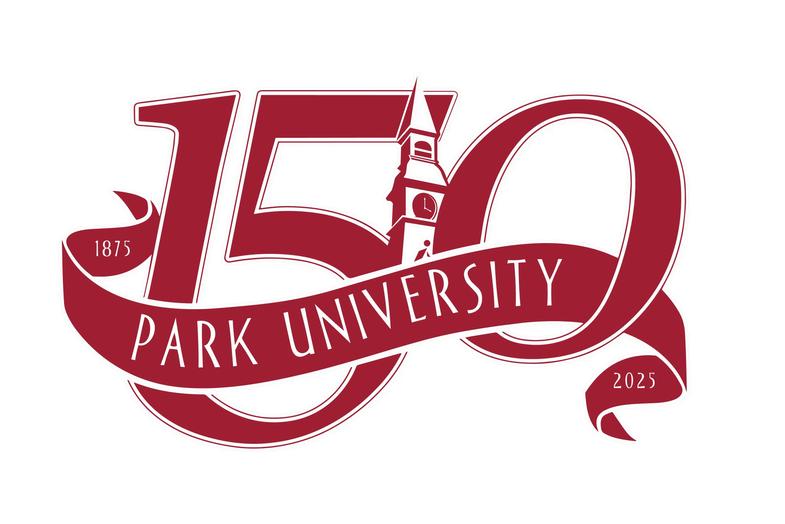
Want to learn more about Park University’s sesquicentennial history? Join Timothy Westcott, Ph D , professor of history and associate university archivist for the following Pirate Chats
Tuesday, Oct. 1, 2024
7:30-8:30 p.m. (Central time)


The Japanese military, within hours of the attack on Pearl Harbor, invaded the American territory of the Philippines and by early May 1942, captured the island On Jan 2, 1942, Japanese forces entered Manila and began interning foreigners, including 3,200 Americans at the University of Santo Tomas Internment Camp. By May 1943, due to overcrowding, internees, including 1,527 Americans, were transferred to a new facility named Los Banos. The transferred Americans included Park alumni Rev. Herbert Blair, 1901; Rev. Roy and Nellie (Pollock) Brown, both 1901; Dr. James and Ethel (Robinson) Chapman, both 1907; and Rev. H. Hugh Bousman, 1917. In late February 1945, led by U.S. Army Airborne and Filipino guerrilla forces, the Los Banos camp was liberated. Unfortunately, not all of the Park alumni survived. Join the chat to learn more about these horrific stories of survival For more information on the Los Banos raid, visit militaryhistorynow com/2019/11/26/raid-on-los-banos-the-ww2-prison-camp-rescue-that-historyforgot
“The Third Founder: Rev. Elisha B. Sherwood”
Tuesday, Jan. 21, 2025
7:30-8:30 p.m. (Central time)


Born in Vermont in 1810, Sherwood completed his theological training at the Oberlin Seminary in 1836 In November 1865, Sherwood journeyed to Missouri and began ministering in Weston Sherwood met George Park in 1866 and Dr John McAfee in 1869 During a visit to Parkville in 1872 to discuss Presbyterian church affairs with Park, the two men discussed locating a college in Parkville. Over the next three years the two men continued conversations until 1875 when Park offered land and a building, and enticed McAfee to depart Highland (Kan.) University. Join the chat to learn more about Sherwood’s establishment of dozens of Presbyterian churches in western Missouri, as chair of the Park College Board of Trustees and relationships with Park and McAfee. Sherwood Home (1890-1907) for women was named for him.
